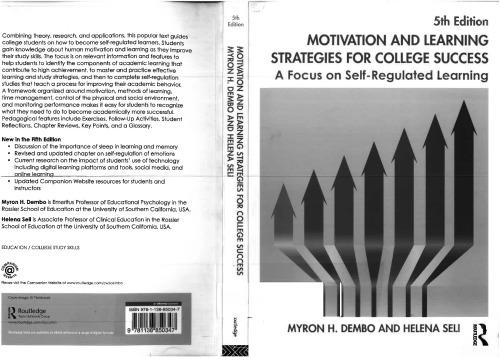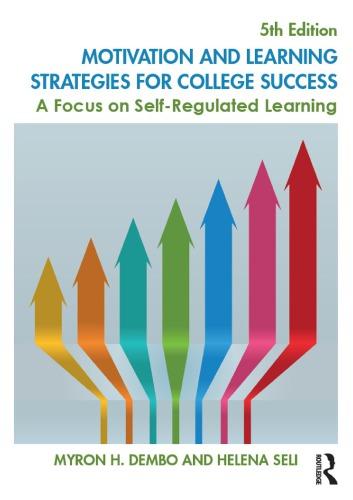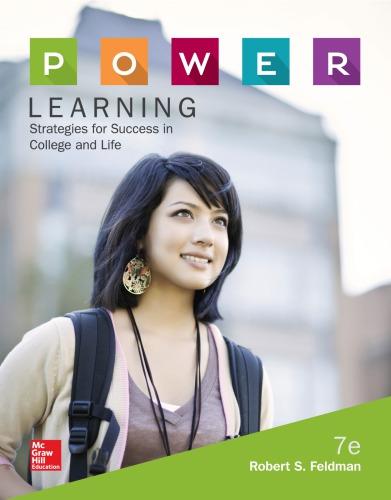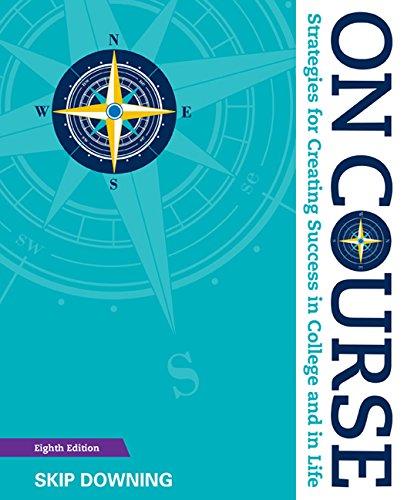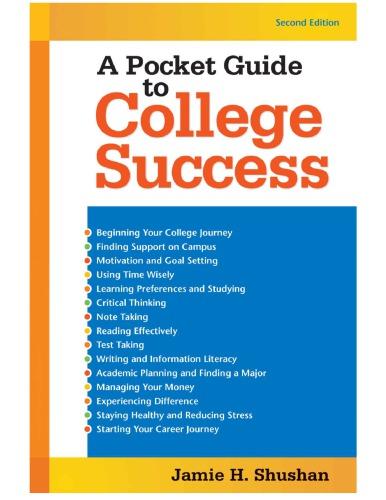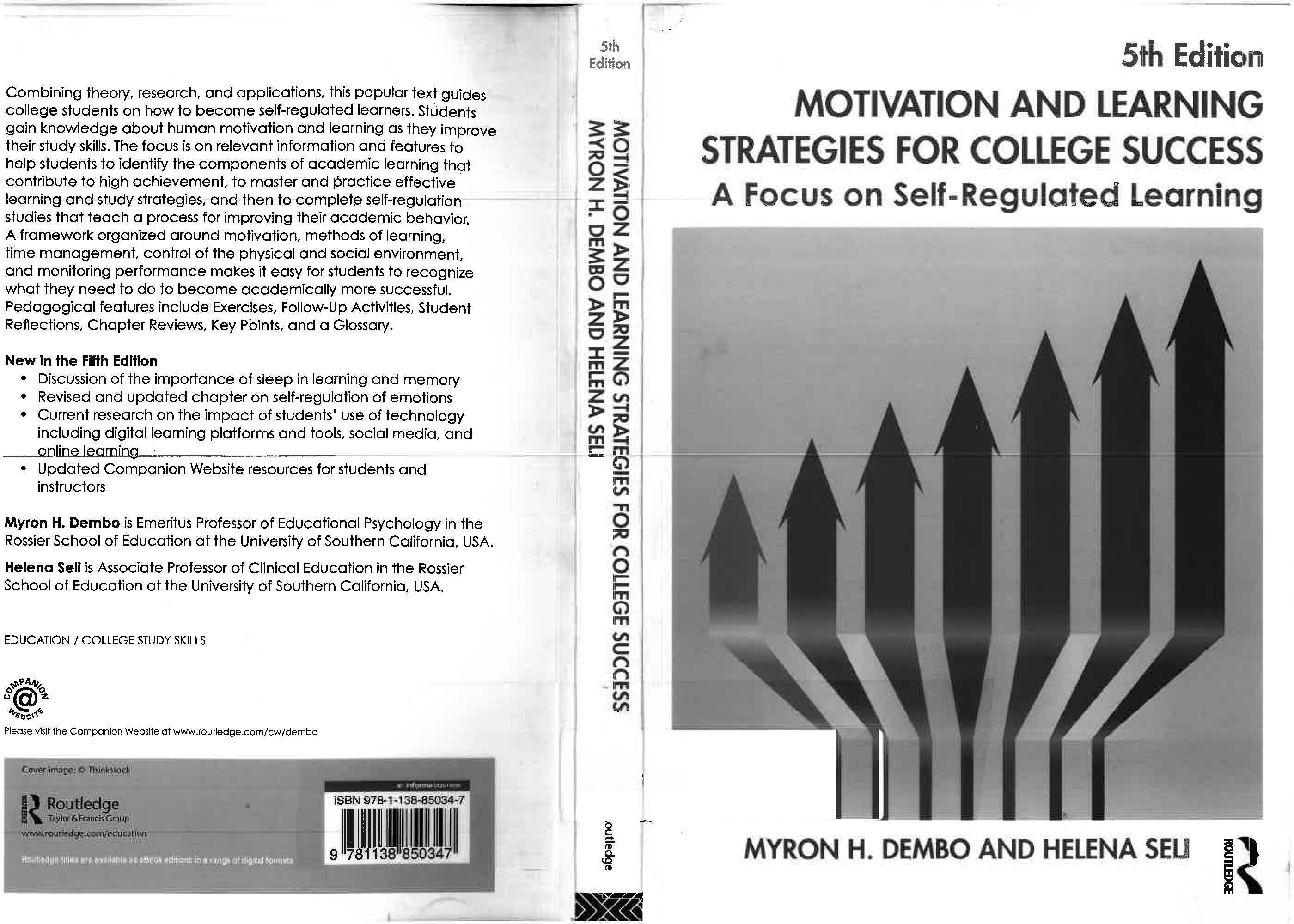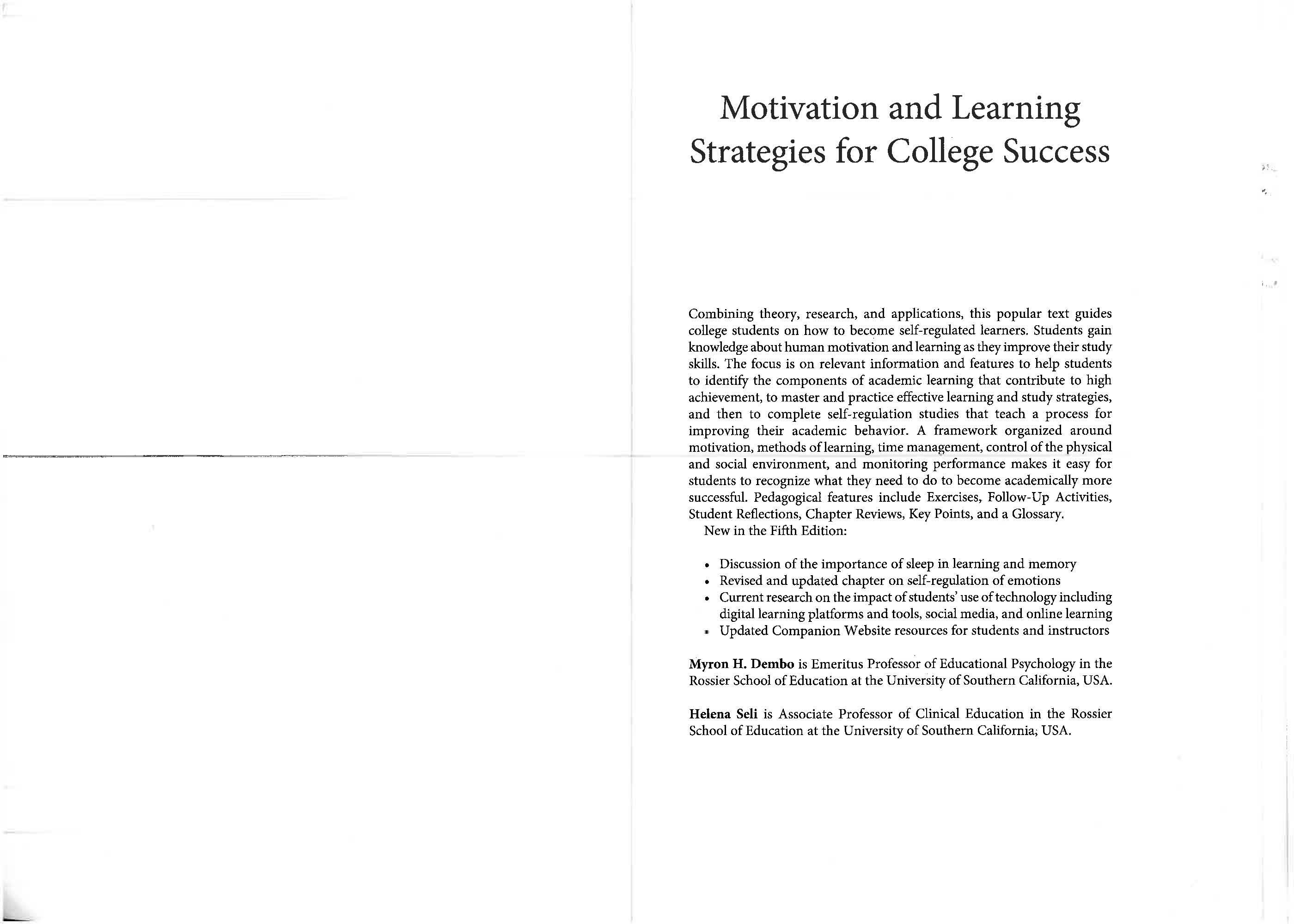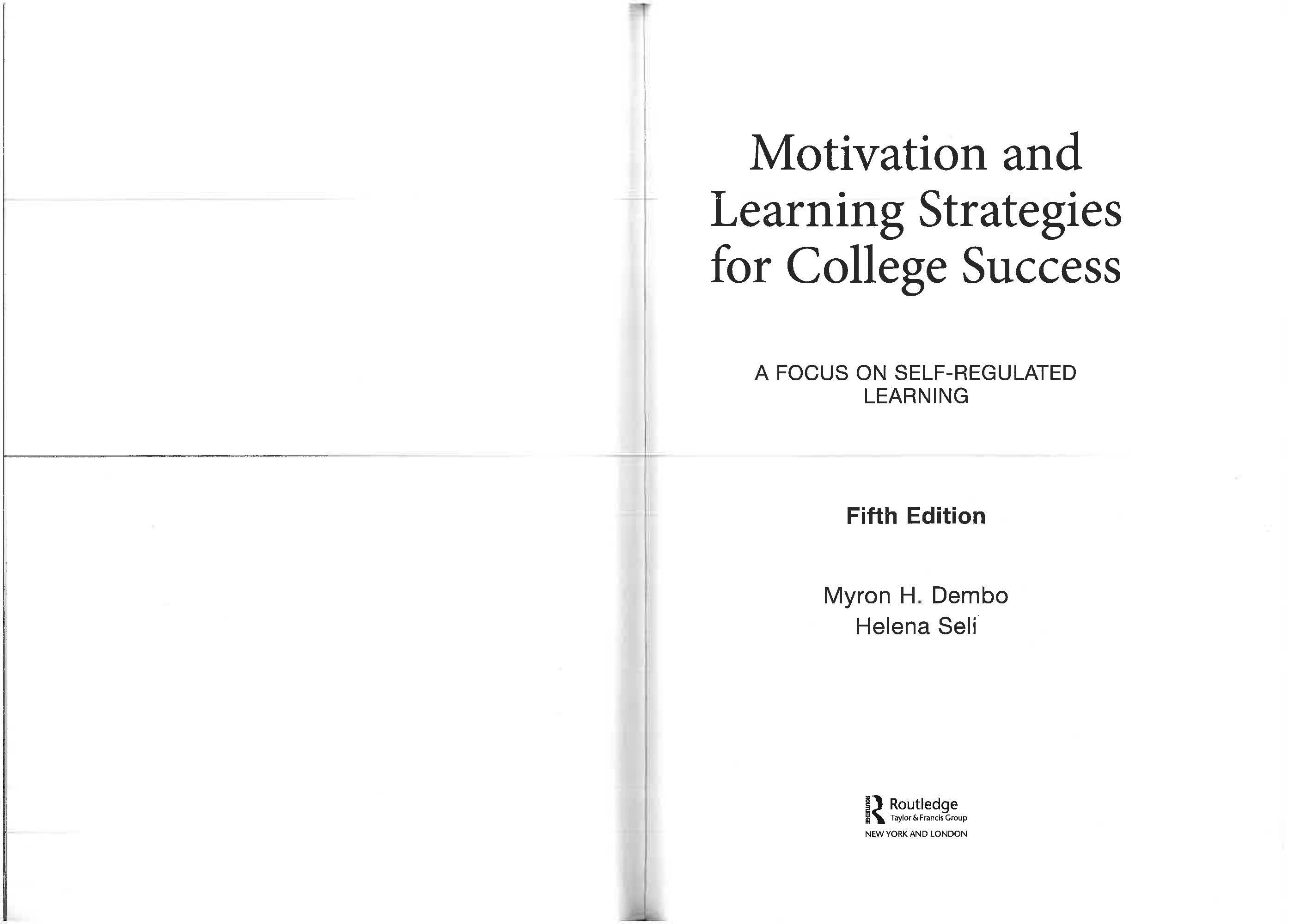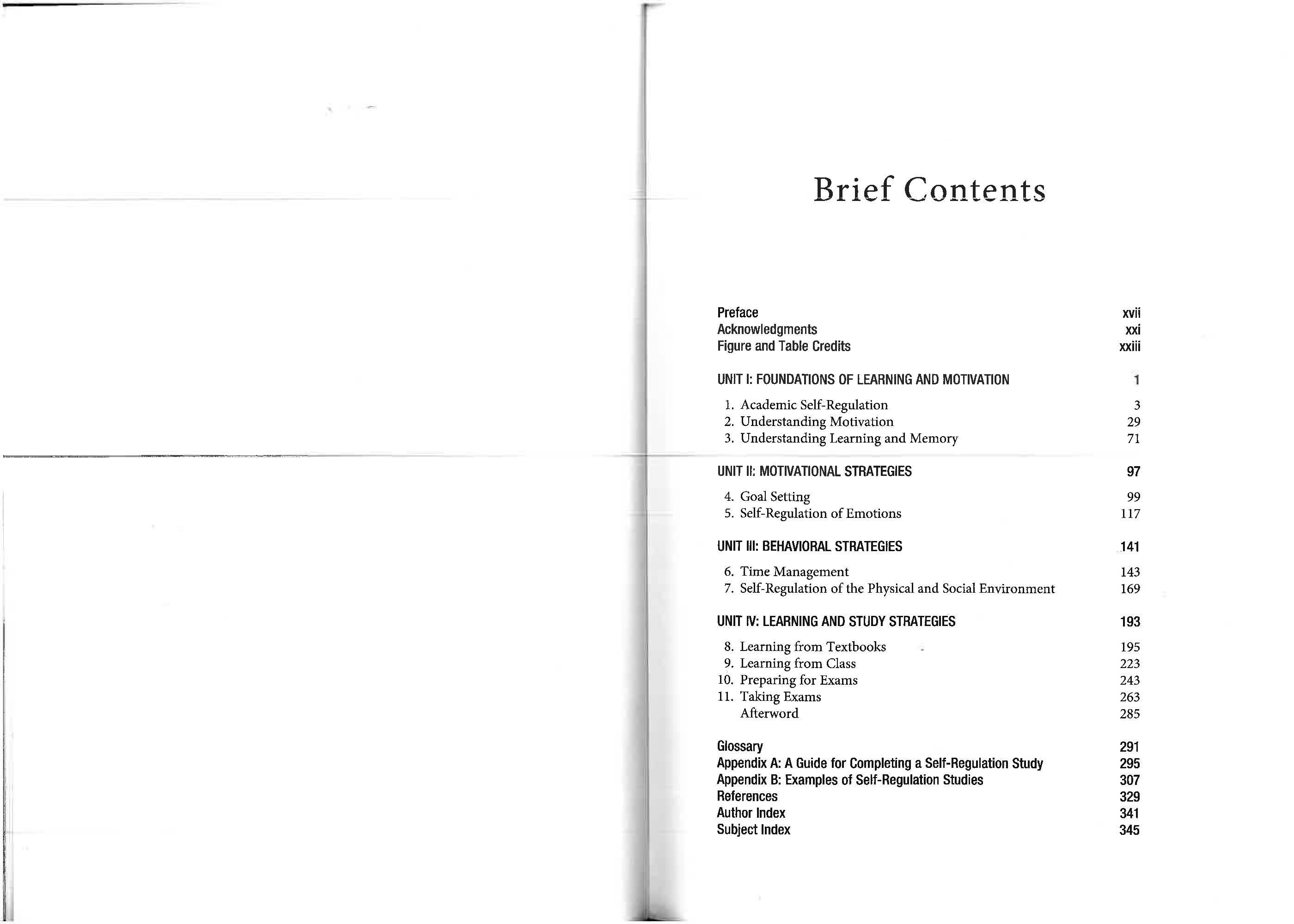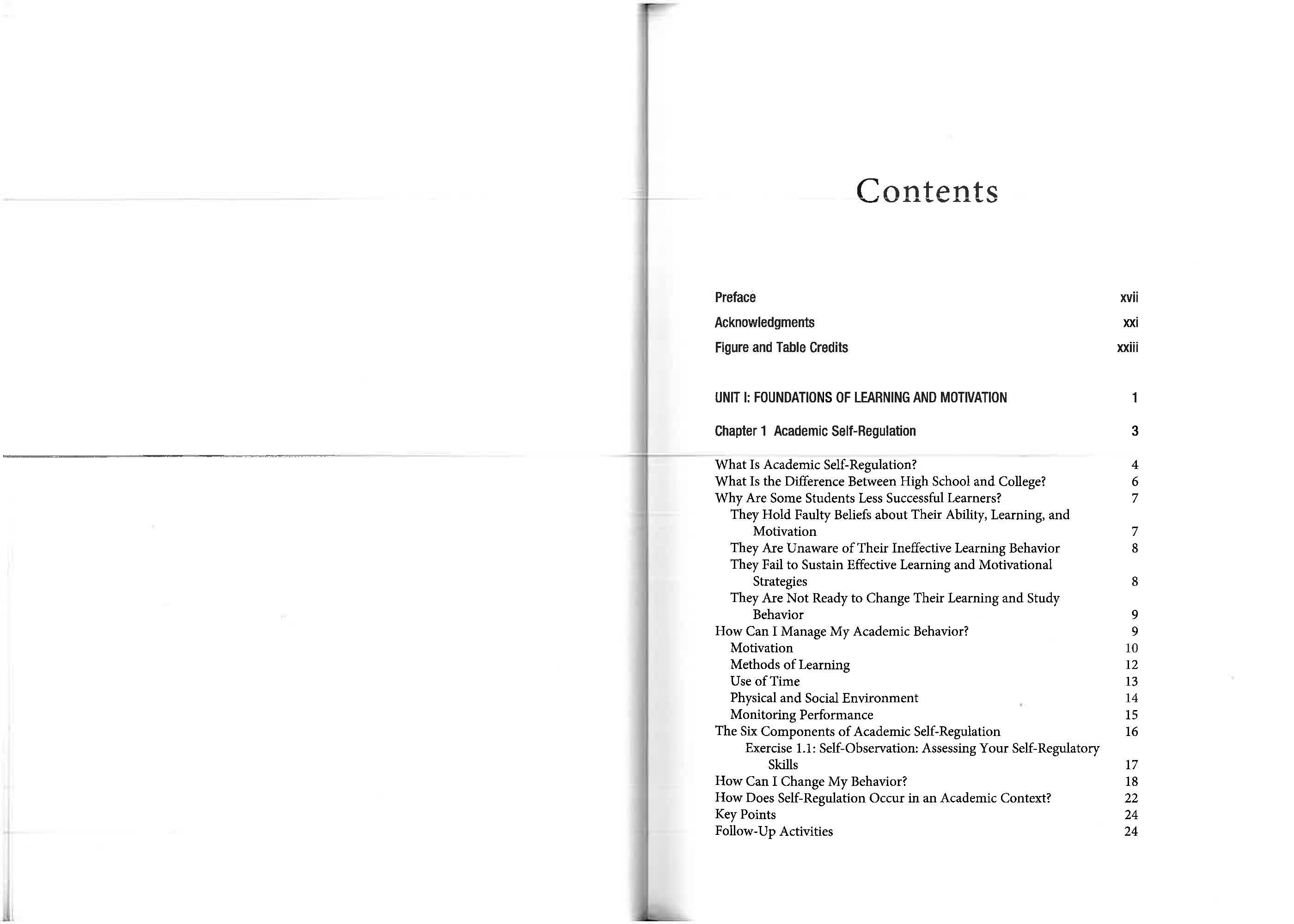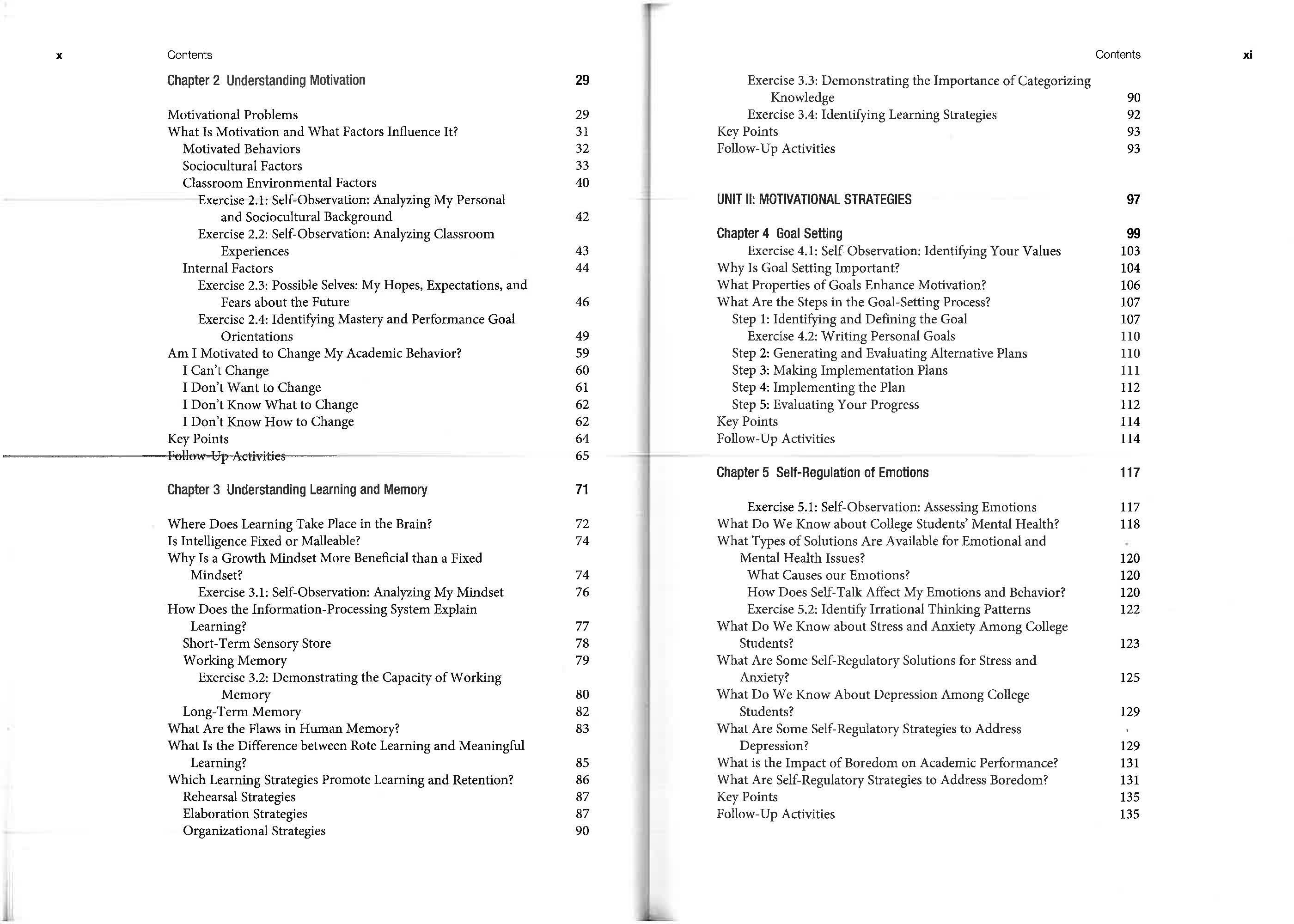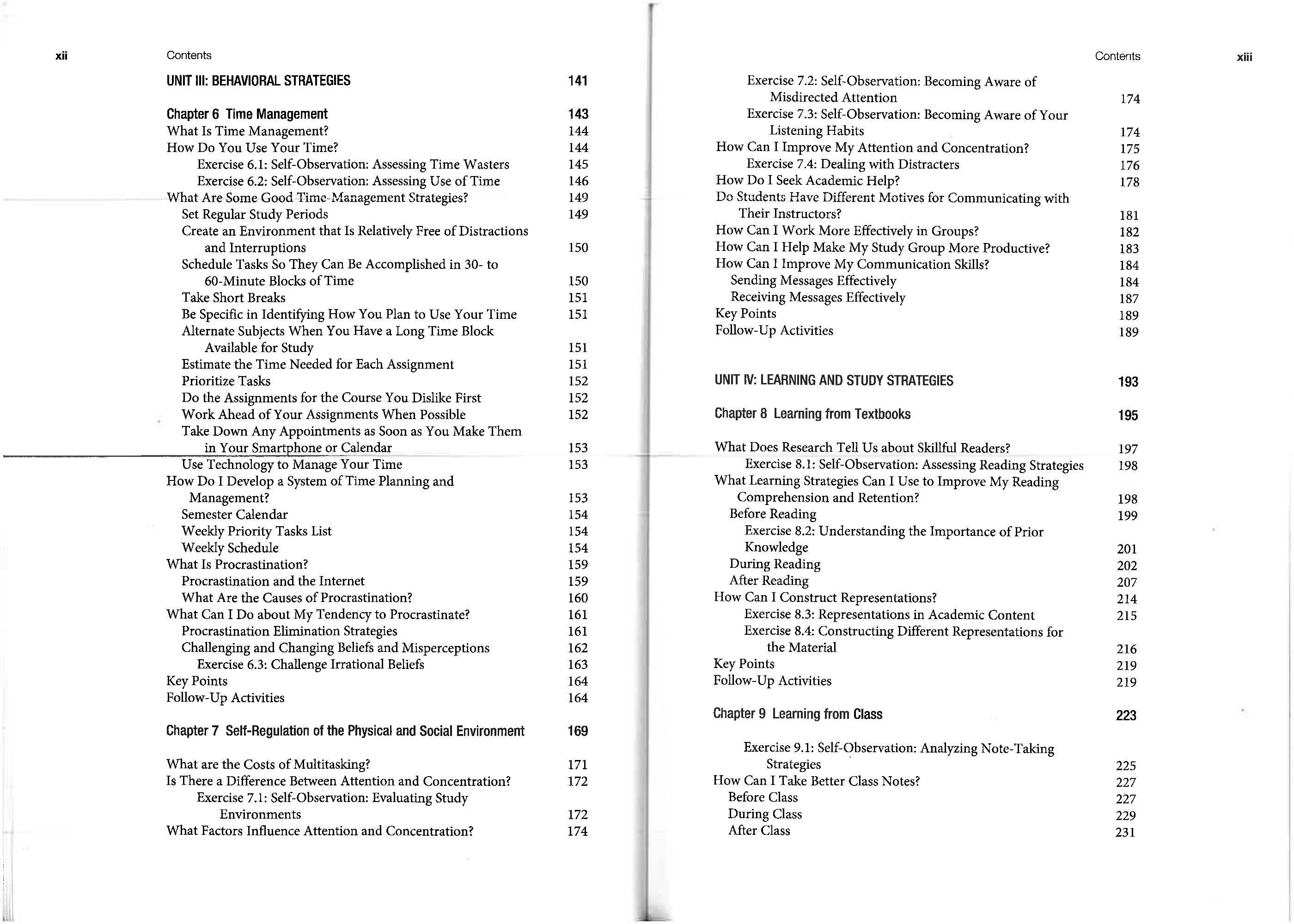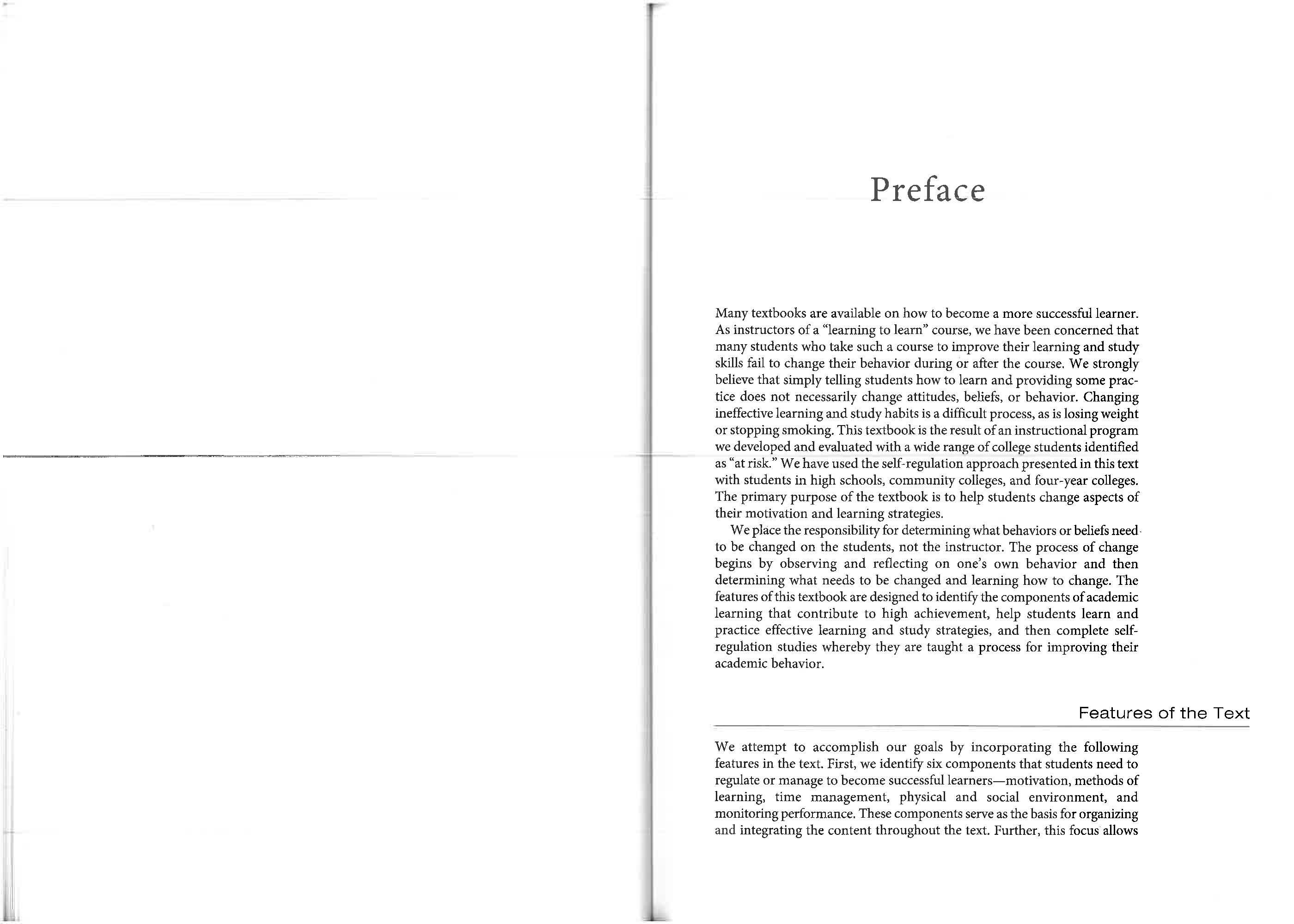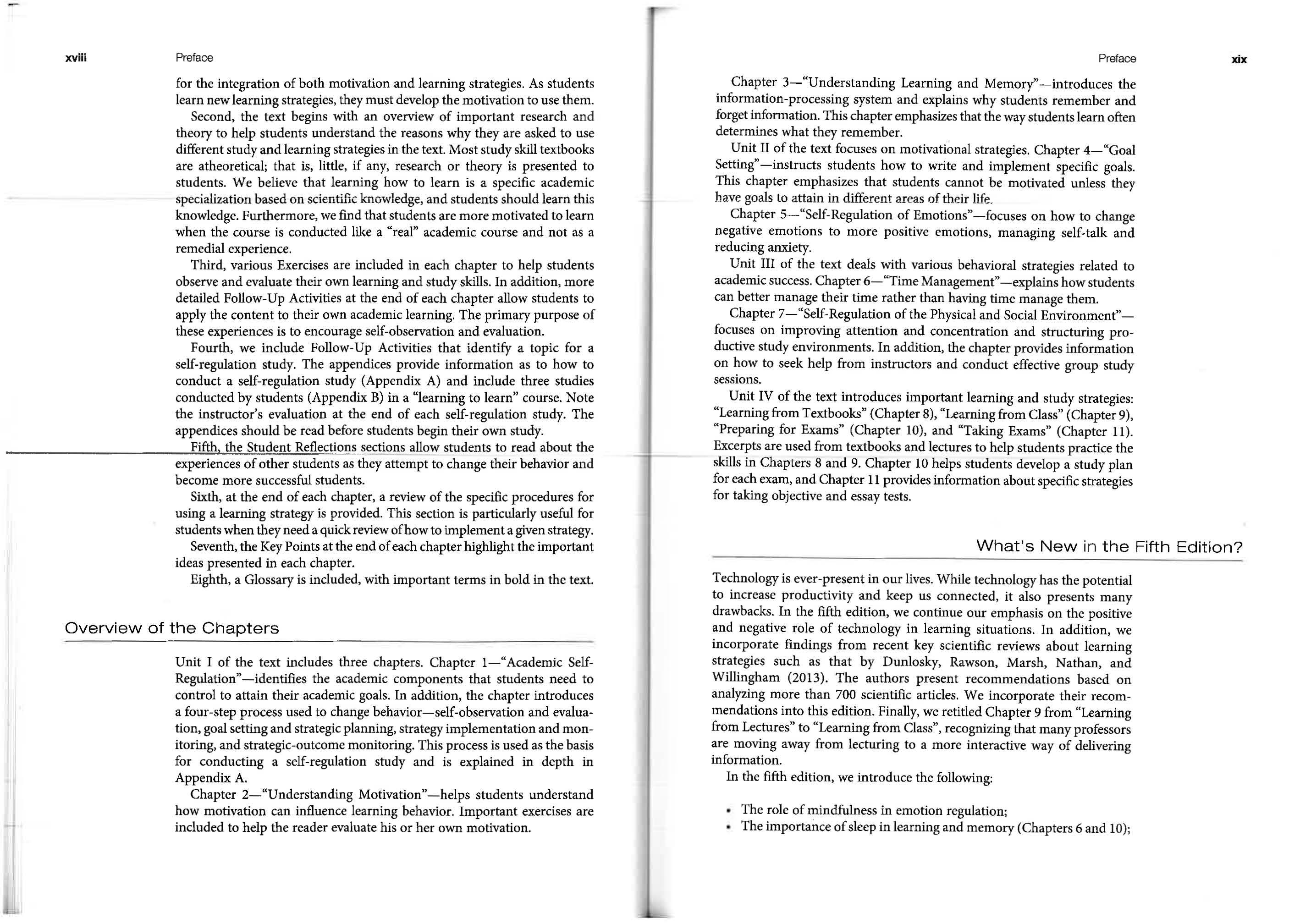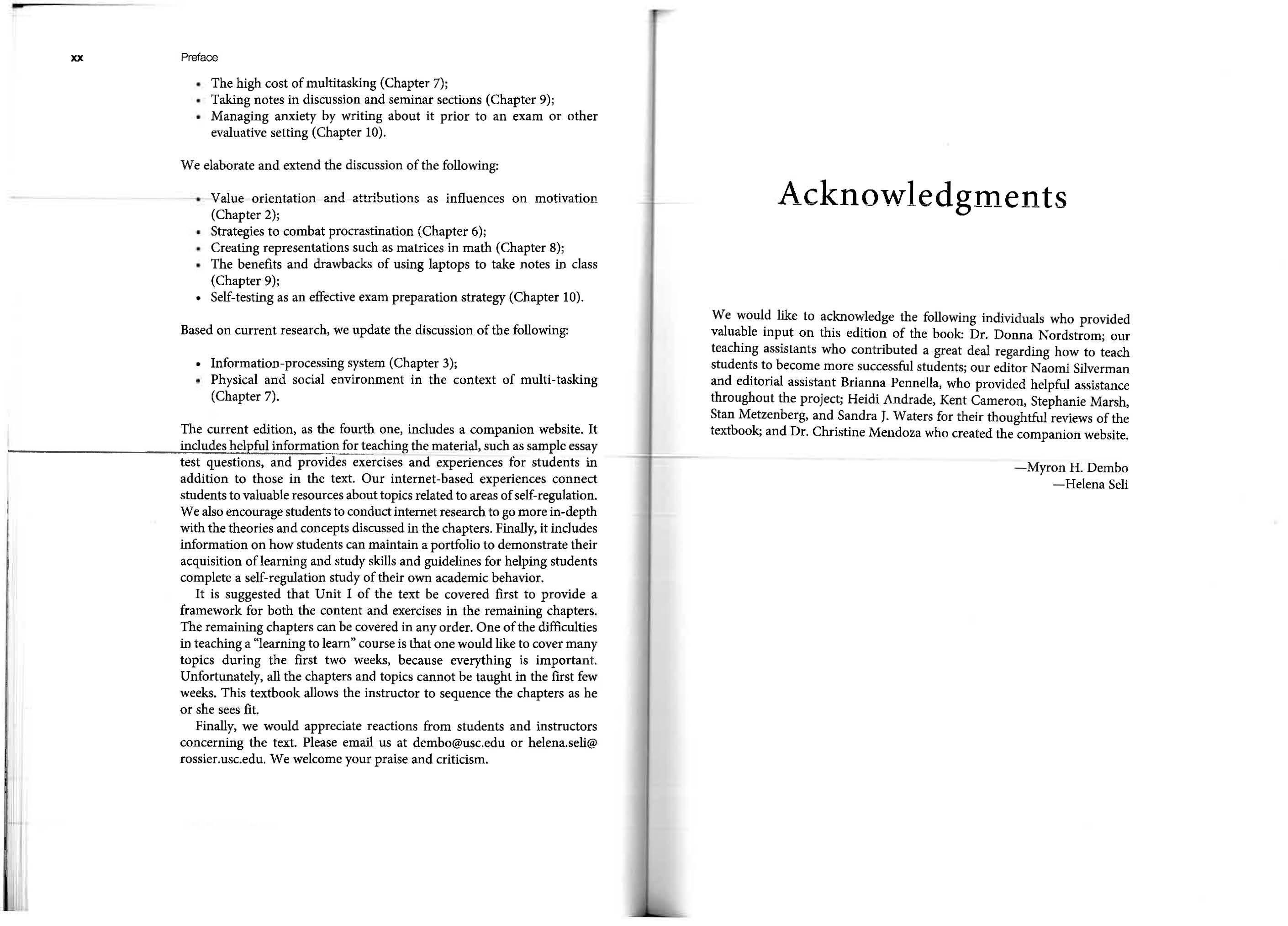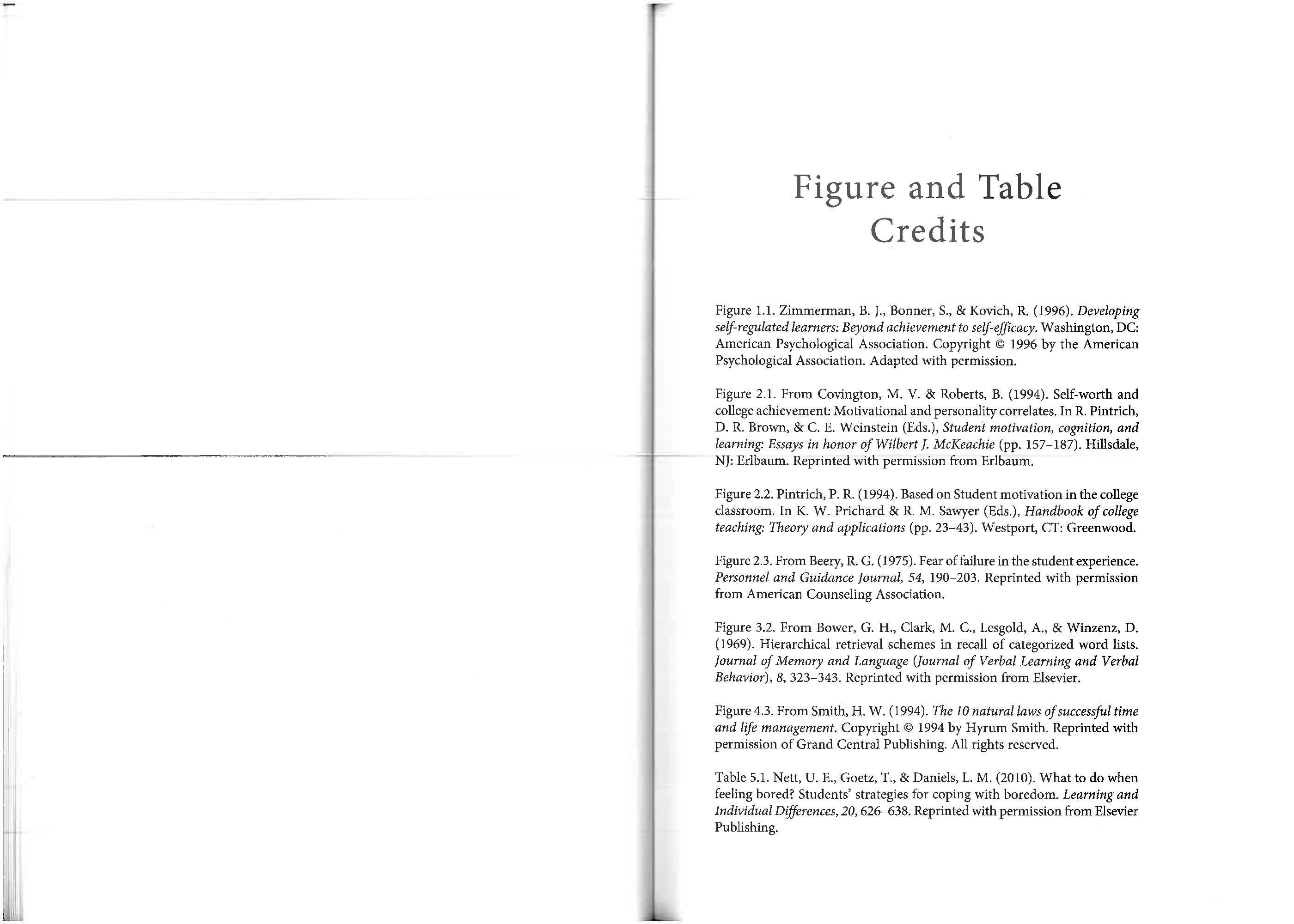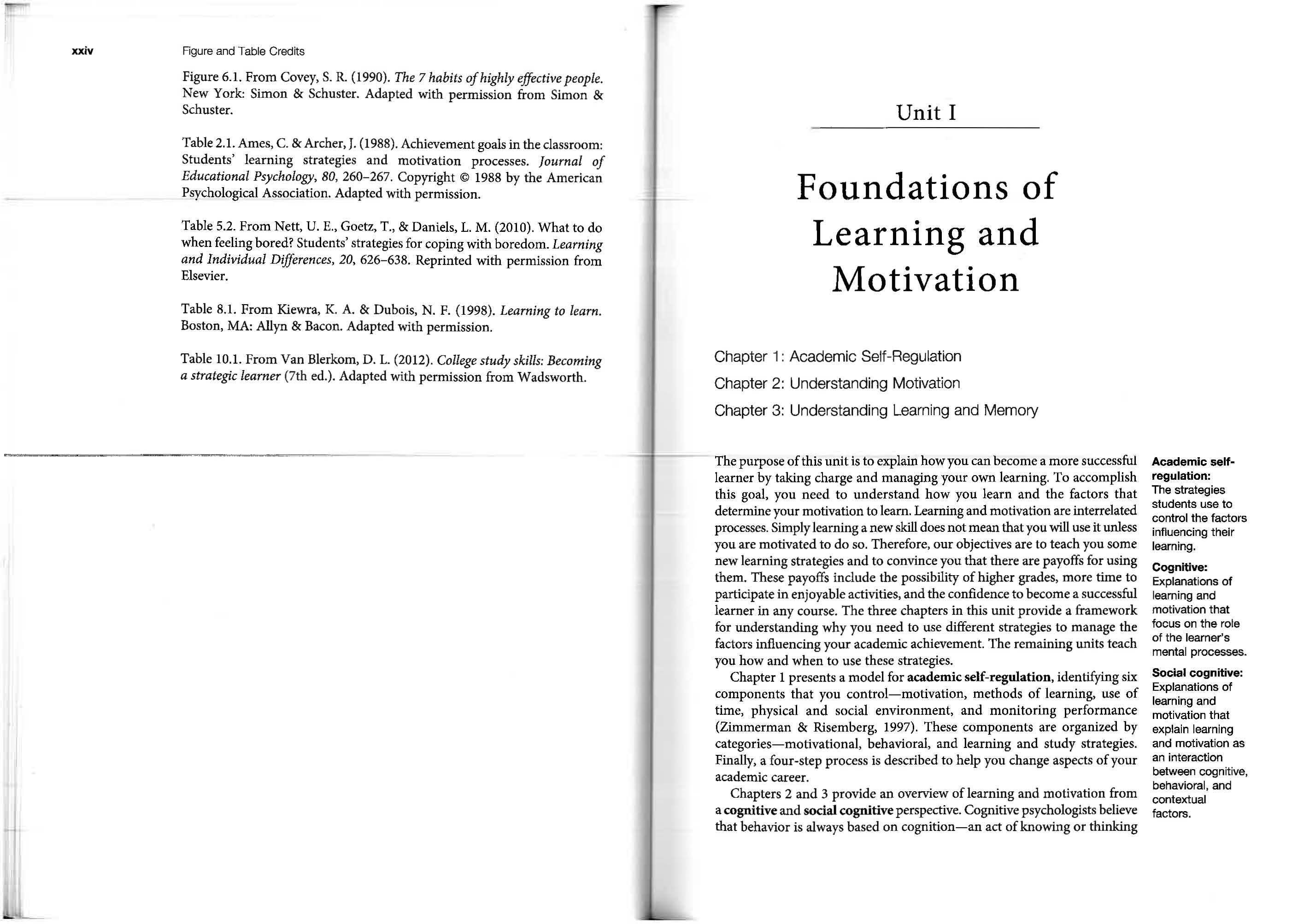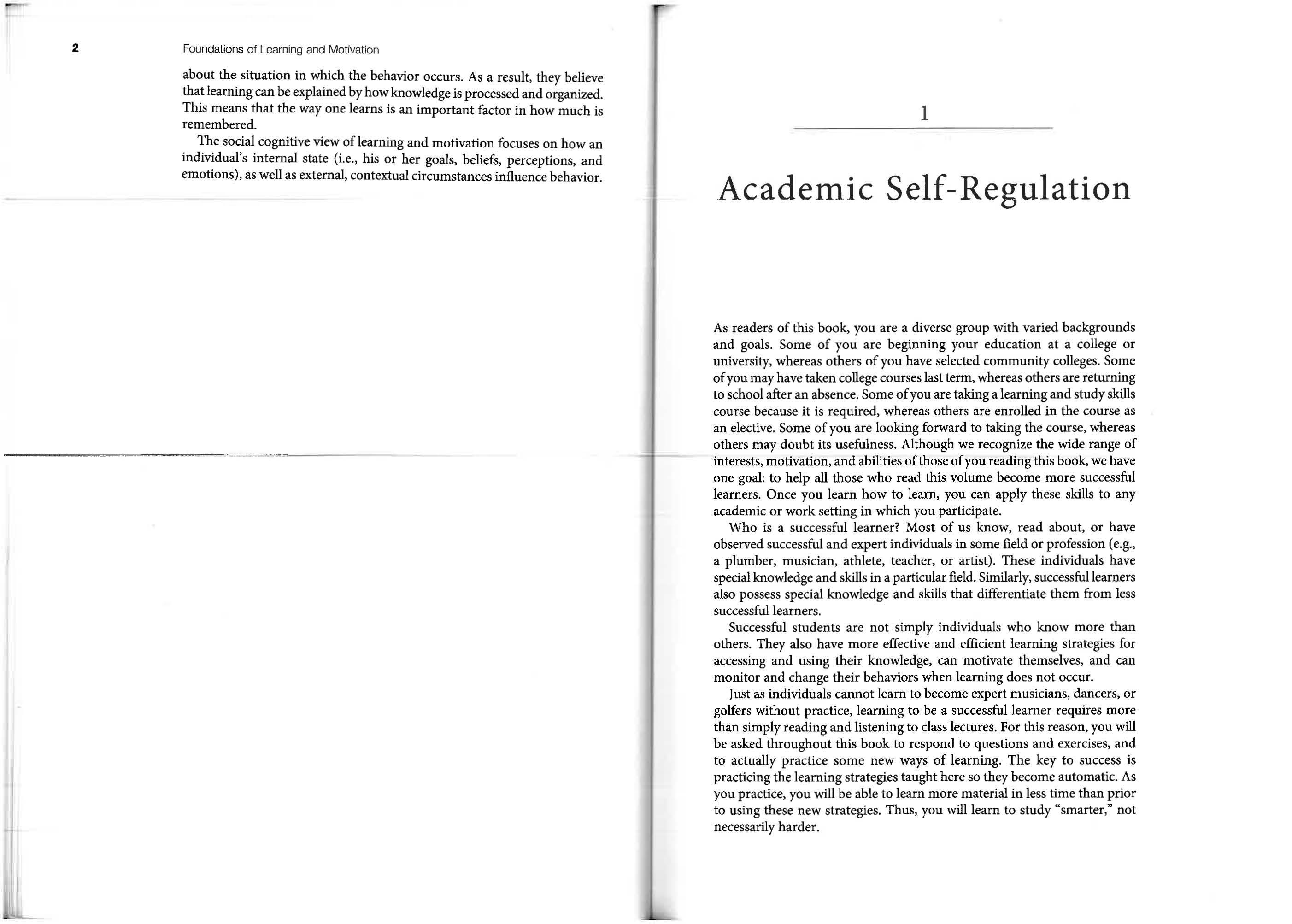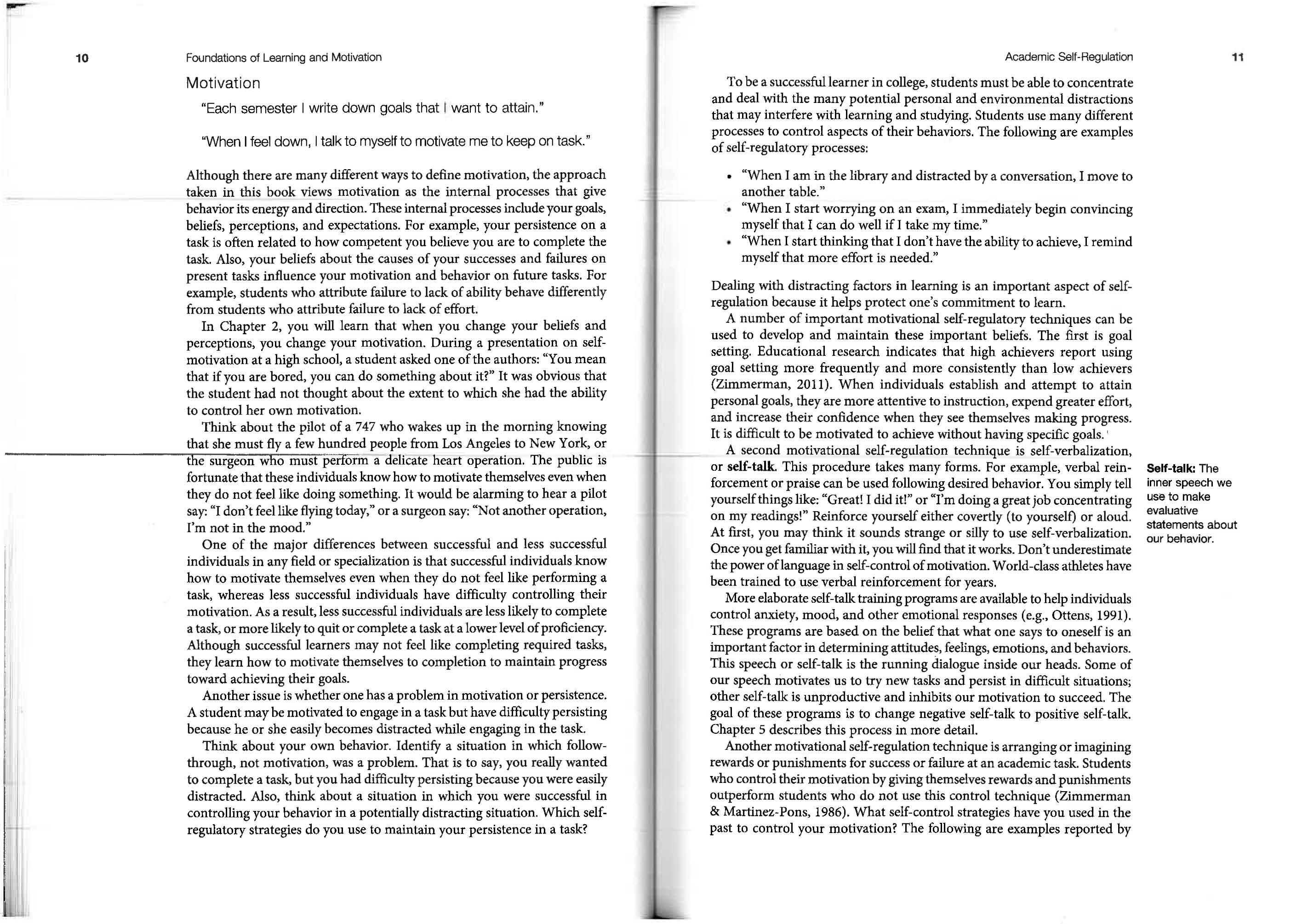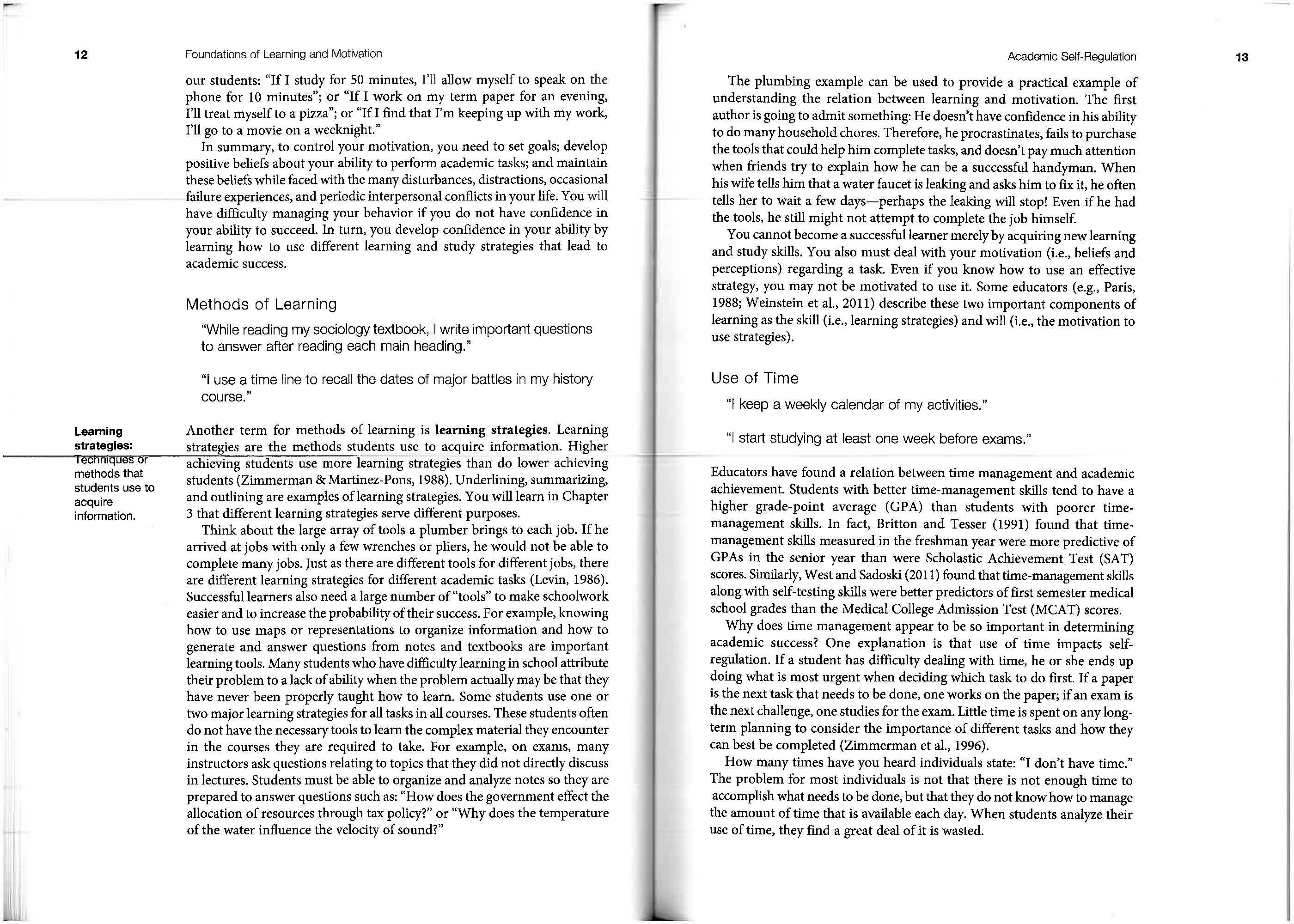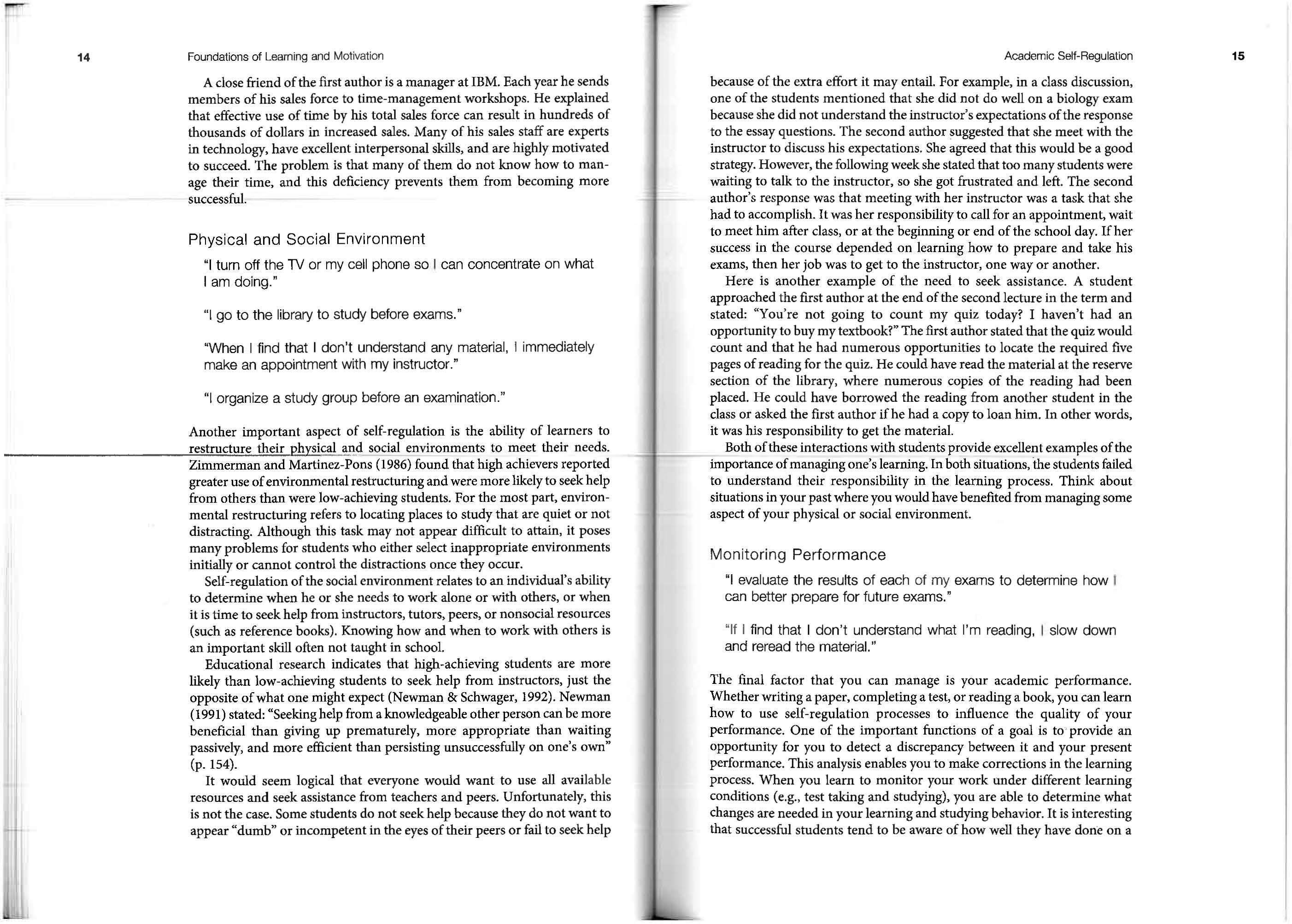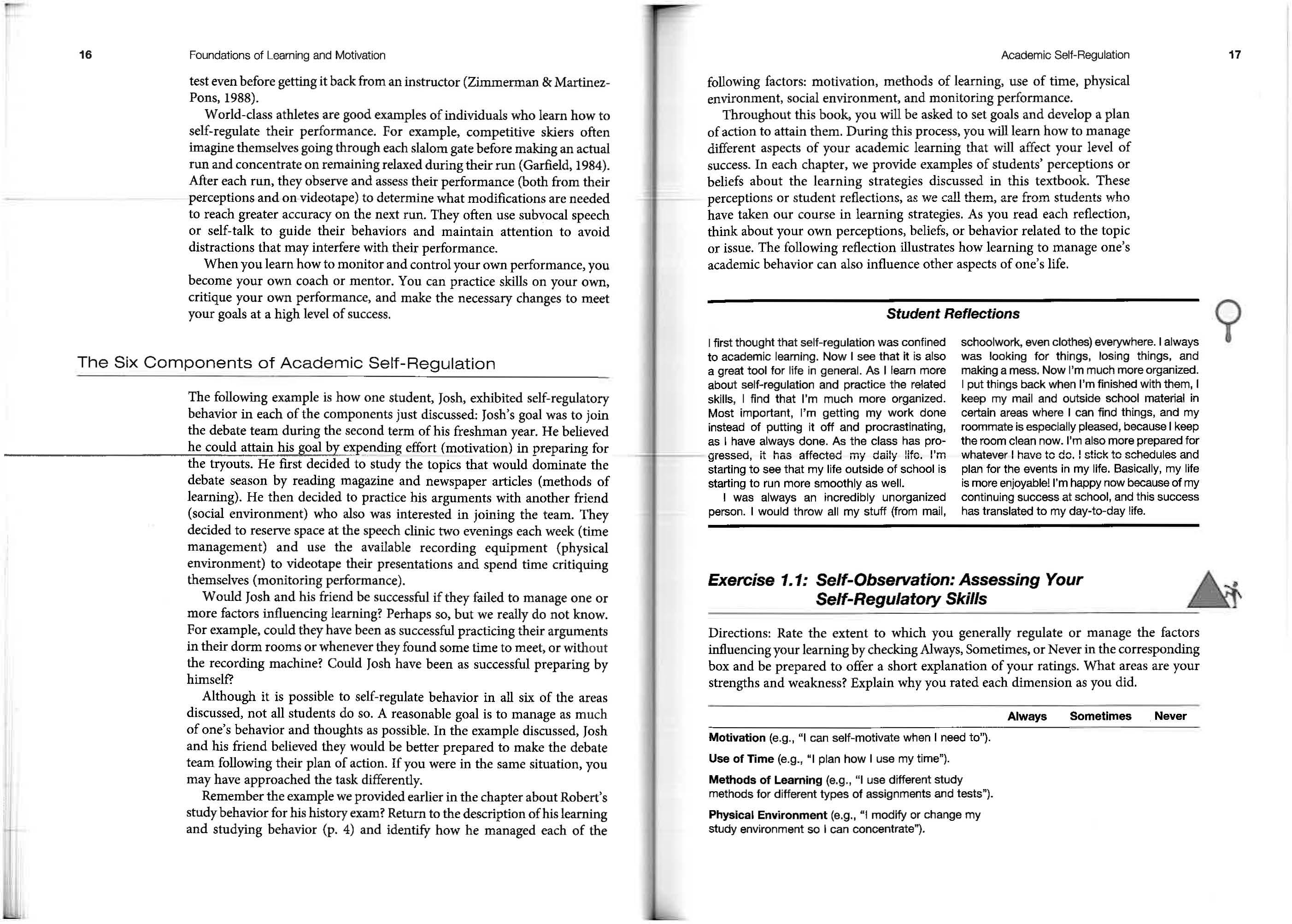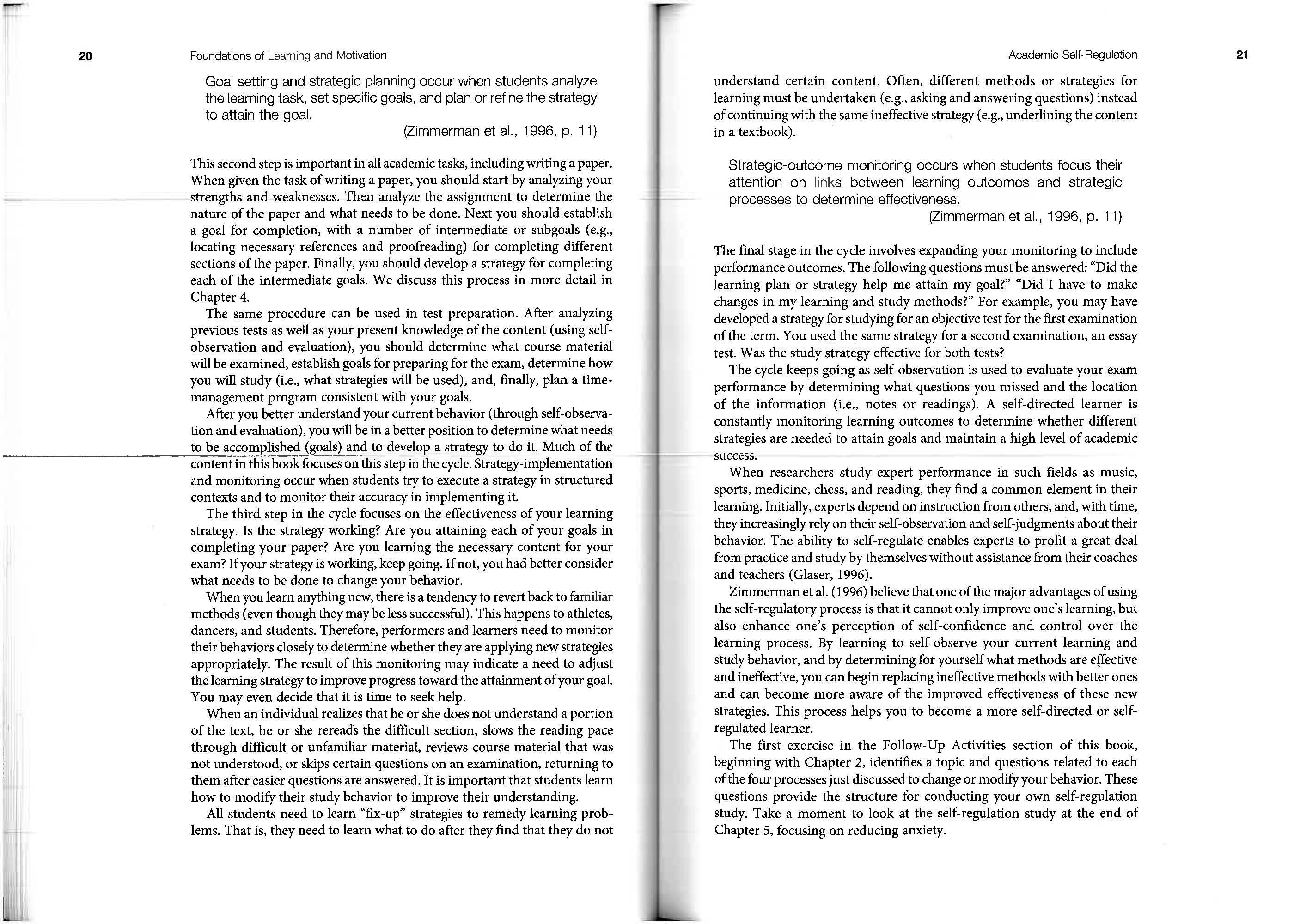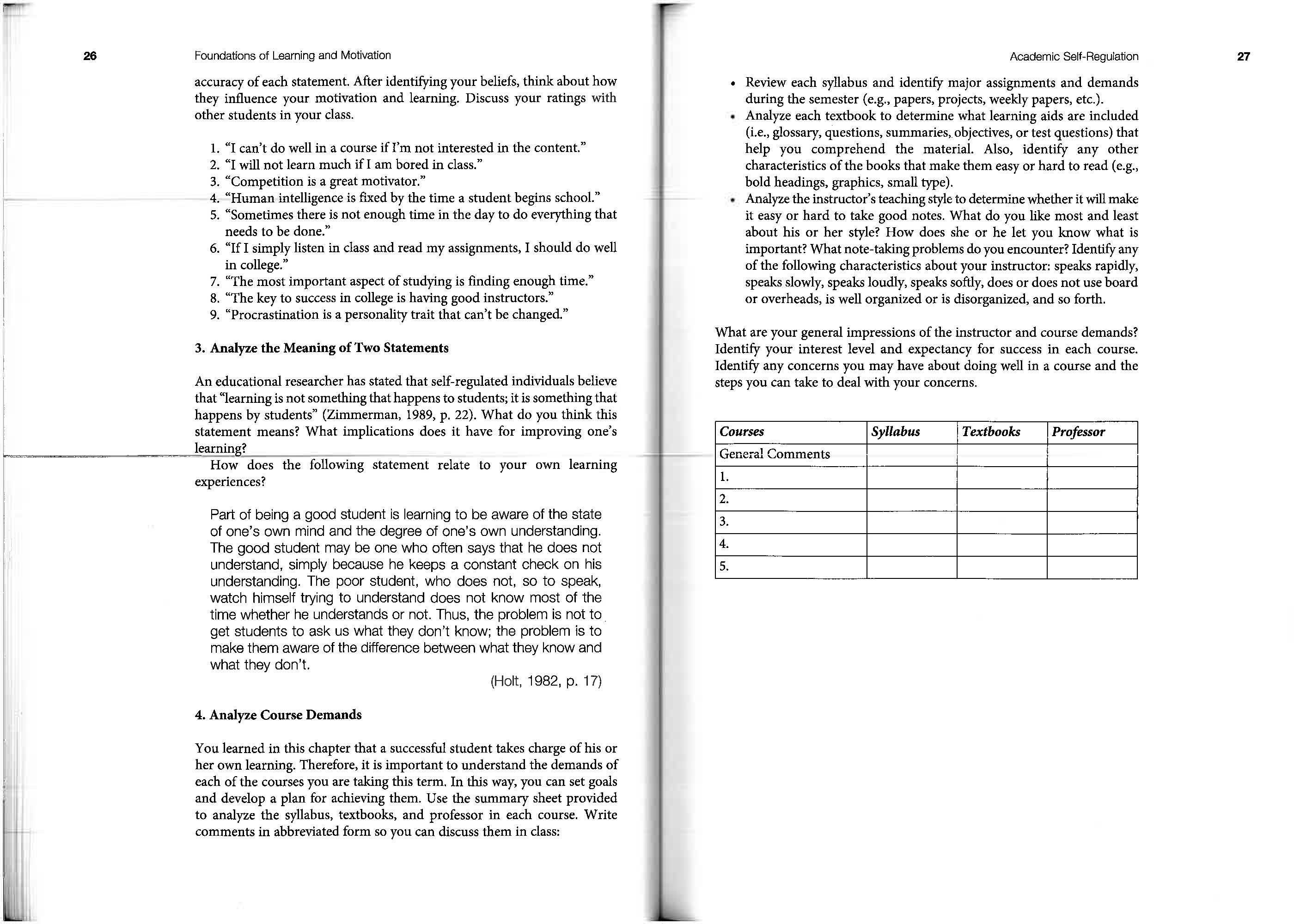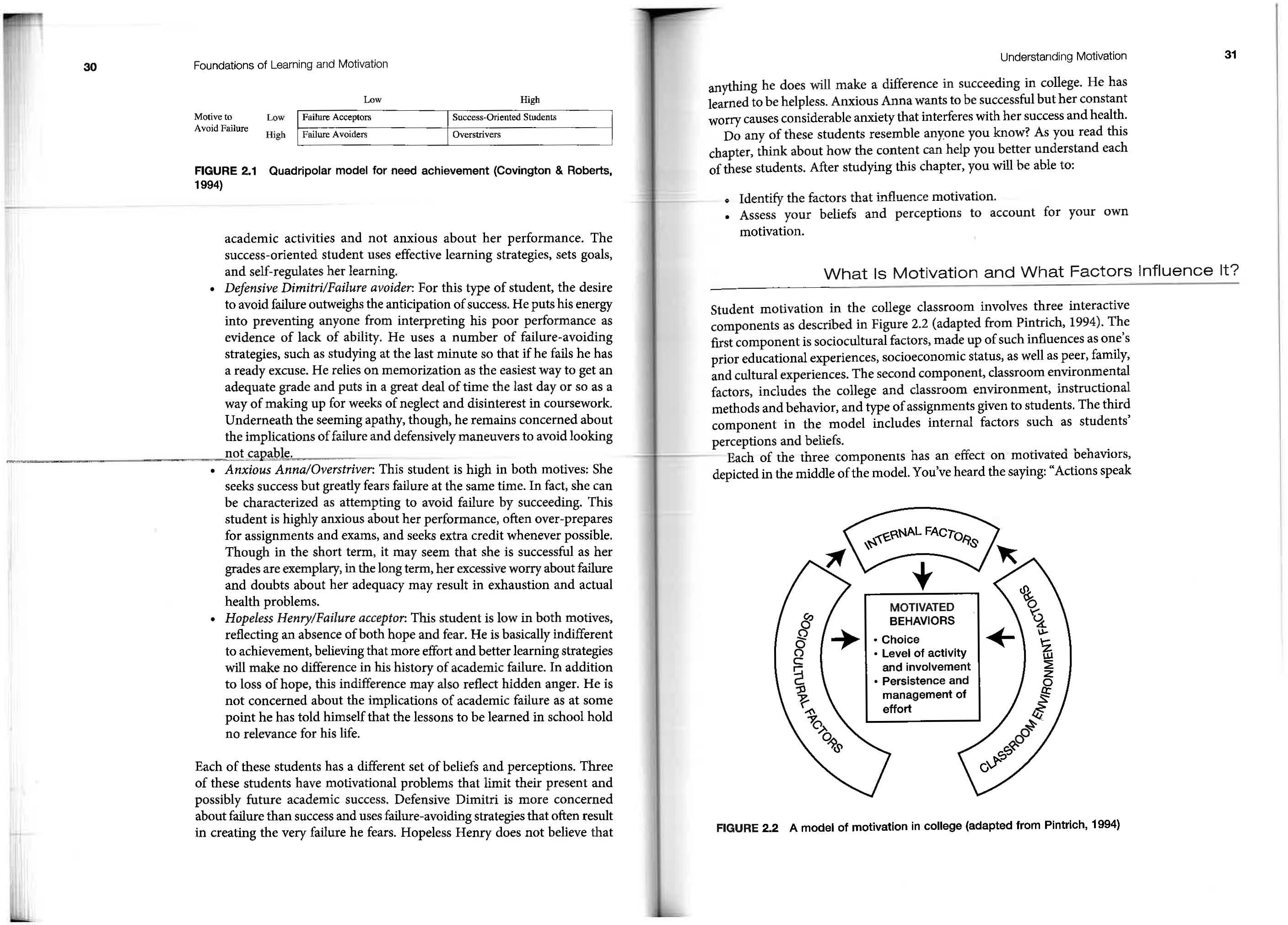Motivation and Learning Strategies for College Success
A FOCUS ON SELF-REGULATED LEARNING
Fifth Edition
Myron H . Dembo
Helena Seli
NEWYORKAND LONDON
Fifth edition published 2016 by Routledge 711 Third Avenue, New York, NY 10017 and by Routledge
2 Park Square, Miltan Park, Abingdon, Oxon OX14 4RN
Routledge is an imprint 01 the TayloT & Francis Group, an informa business © 2016 Taylar & Frands
The right of Myron H. Dembo and Helena Seli to be identified as authors of this work ha:. been asserteu by them in accorJance wii.h seetians 77 and 78 of the Copyright, Designs and Patents Act 1988.
AH rights reserved. No part of this book may be reprinted or reproduced or utilised in any form or by any electronic, mechanical, or other means, now known or hereafter invented, including photocopying and recording, or in any information storage or retrieval system, withaut permission in writing from the publishers.
Trademark notice: Product or corporate names may be trademarks or registered trademarks, and are llsed onIy far identificatian and explanatian without intent to infringe.
First edition published by Routledge 2000
Fourth edition pubBshed by Routledge 2013 Library of Congress Cataloging in Publication Data Dembo, Myron H. 1Seli, Helena.
Title: Motivation and learning strategies for college success : a focus on self-regulated learning / by Myron H. Dembo and Helena SeBo
Description: New York: Rautledge, 2016.1 Ineludes bibBographical references and indexo
Identifiers: LCCN 2015049701 (print) 1LCCN 2016000507 (ebaok) 1
ISBN 9781138850330 (Hardback) 1ISBN 9781138850347 (Paperback) 1 IsBN 9J813IS124775( eBoak)
Subjects: LCSH: College student orientation. 1Achievement motivation. Learning strategies.
Classificatian: LCC LB2343.3 .D46 2016 (priot) 1 LCC LB2343.3 (eboak) I DDC 371.26-dc23
ISBN, (hbk)
ISBN, (pbk)
ISBN: 978-1-315-72477-5 (ebk)
Typeset in Minion Pro and Helvetica Neue by Florence Production Ltd, Stoodleigh, Devon, UK
To Nancy, Lisa, Deborah, Brayden, and Taylor
To Gerry, Thomas, Lukas, and Annalisa
Preface
Many textbooks are available on how to become a more successfullearner. As instructors of a "learning to learn" course, we have been co ncerned that many students who take such a course to improve their learning and study skills fail to change their behavior during or after the course. We strongly believe that simply telling students how to learn and providing sorne practice does not necessarily change attitudes, beliefs, or behavio r. Changing ineffective learning and study habits is a difficult process, as is losing weight or stopping smoking. This textbook is the result of an instructio nal program we developed and evaluated with a wide range of college students identified as "at risk." We have used the self-regulation approach presente d in this text with students in high schools, community colleges, and four-y ear colleges. The primary purpose of the textbook is to help students change aspects of their motivation and learning strategies.
We place the responsibility for determining what behaviors or beliefs need· to be changed on the students, not the instructor. The proces s of change begins by observing and reflecting on one' s own behavio r and then determining what needs to be changed and learning how to change. The features of this textbook are designed to identify the components of academic learning that contribute to high achievement, help student s learn and practice effective learning and study strategies, and then co mplete selfregulation studies whereby they are taught a process for imp roving their academic behavior.
Features of the Text
We attempt to accomplish our goals by incorporating th e following features in the text. First, we identify six components that students need to regulate or manage to become successfullearners-motivation, methods of learning, time management, physical and social environ ment, and monitoring performance. These components serve as the basis fo r organizing and integrating th e content throughout the texto Further, this focus allows
for Ihe integration of both motivation and leaming strategies. As students leam new leaming strategies, Ihey must deve10p Ihe motivation to use Ihem.
Seeond, the text begins wilh an overview of important researeh and theory to he1p students understand the reasons why Ihey are asked to use difierent study and leaming strategies in Ihe text. Most study skill textbooks are alheoretieal; that is, liule, if any, researeh or Iheory is presented to students. We believe that learning how to leam is a specific academic specialization based on scientific knowledge , and students should leam thi s knowledge. Furlhermore, we find Ihat students are more motivated to leam when Ihe course is conducted like a "real" academie course and not as a remedial experience.
Third, various Exereises are induded in each chapter to help students observe and evaluate their own learning and study skills. In addition, more detailed Follow-Up Aetivities at the end of eaeh ehapter allow students to apply Ihe content to Iheir own academic leaming. The primary purpose o f these experiences is to encourage self-observation and evaluation.
Fourth, we indude Follow-Up Activities that identify a topie for a self-regulation study. The appendiees provide information as to how to conducl a self-regulation study (Appendix A) and indude three studies conducted by students (Appendix B) in a "leaming to leam" course. Note the instructor's evaluation at Ihe end of each self-regulation study. The appendiees should be read before students begin their own study.
seetions allow students to read about the experiences of other students as Ihey aUempt to ehange Iheir behavior and become more successful students.
Sixth, at Ihe end of each chapter, a review of the specific procedures for using a learning strategy is provided. This section is particularly useful for students when they need a quick review ofhow to implement a given strategy.
Seventh, the Key Points at the end of each chapter highlight the important ideas presented in each chapter.
Eighlh, a Glossary is inc1uded, wilh important terms in bold in the tex!.
Overview of the Chapters
Unit I of Ihe text indudes three ehapters. ehapter l-"Academie SelfRegulation" -identifies the academic components Ihat students need to control to attain their academic goals. In addition, the chapter introduces a four-step process used to change behavior-self-observation and evaluation, goal setting and strategie planning, strategy implementation and monitoring, and strategie-outeome monitoring. This proeess is used as the basis for eonducting a self-regulation study and is explained in depth in Appendix A.
ehapter 3-"Understanding Leaming and Memory" - introduces Ihe information-processing system and explains why students remember and forget information. This ehapter emphasizes Ihat Ihe way students leam ofien determines what they remember.
Uni! II of the text foeuses on motivational strategies. ehapter 4- "Goal SeUing" -instruets students how to write and implement specific goals. This chapter emphasizes Ihat students cannot be motivated unless they have goals to aUain in difierent areas of Iheir life.
ehapter 5-"Self-Regulation of Emotions"-focuses on how to ehange negative emotions to more positive emotions, managing self-talk and reducing anxiety.
Unit III of the text deals with various behavioral strategies related to academie suceess. ehapter 6- "Time Management" -explains how students can better manage Iheir time rather Ihan having time manage Ihem.
ehapter 7- "Self- Regulation of the Physical and Social Environment"foeuses on improving atlention and eoncentration and structuring productive study environments. In addition, Ihe chapter provides information on how to seek help from instructors and conduct efiective group study sessions.
Unit IV of the tex! introduces important leaming and study strategies: "Leaming from Textbooks" (ehapter 8), "Leaming from elass" (ehapter 9), "Preparing for Exams" (ehapter 10), and "Taking Exams" (ehapter 11) . Excerpts are used from textbooks and leetures to help students practiee lhe skills in ehaplers 8 and 9. ehapter 10 helps students develop a study plan for each exam, and ehapler 11 provides information aboul speeific strategies for taking objective and essay tests.
What's New in the Fifth Edition?
Technology is ever-present in our lives. While technology has the potential lo inerease produetivity and keep us conneeted, it also presents many drawbaeks. In the fifth edition, we continue our emphasis on Ihe positive and negative role of technology in leaming situations. In addition, we incorporate findings from recent key scientifie reviews about leaming strategies sueh as that by Dunlosky, Rawson, Marsh, Nathan, and Willíngham (2013). The aulhors present recommendations based on analyzing more than 700 scientific artieles. We incorporate their recommendations into tbis edition. Finally, we retitled ehapler 9 from "Leaming from Lectures" to "Leaming from elass", recognizing Ihat many professors are moving away from lecturing to a more interaetive way of delivering information.
In Ihe fifth edition, we introduce Ihe following:
The role of mindfulness in emotion regulation; The importance of sleep in leaming and memory (ehapters 6 and 10) ;
ehapter 2-"Understanding Motivation"-helps students understand how motivation can infiuence leaming behavior Important exercises are included to help Ihe reader evaluate his or her own motivation. Prelace
• The high cost of multitasking (Chapter 7); Taking notes in discussion and seminar sections (Chapter 9); Managing anxiety by writing about it prior to an exam or other evaluative setting (Chapter 10).
We elaborate and extend the discussion of the following:
Value orientation and attributions as influences on motivation (Chapter 2); Strategies to combat procrastination (Chapter 6); Creating representalions such as matrices in math (Chapter 8); The benefits and drawbacks of using laptops to take notes in dass (Chapter 9);
• Self-testing as an effective exam preparation strategy (Chapter 10)
Based on eurrent researeh, we update the diseussion of the following:
• Information-processing system (Chapter 3); Physical and social environment in the context of multi-tasking (Chapter 7).
The current edition, as the fourth one, indudes a companion website. lt indudes helpful information for teaehing the material, sueh as sample essay test questions, and provides exereises and experiences for students in addition to those in the texto Our internet - based experiences eonnect students to valuable resources about topics related to areas of self-regulation. We a1so encourage students to conduct internet research to go more in-depth with the theories and concepts discussed in the chapters. Finally, it ineludes information on how students can maintain a portfolio to demonstrate their acquisition of learning and study skills and guidelines for helping students complete a self-regulation study of their own academic behavior. It is suggested Ihat Unit 1 of the text be covered first to provide a framework for both the content and exercises in the remaining chapters. The remaining chapters can be covered in any order. One of the difficulties in teaching a "learning to learn» COUTse is that one would like to cover many topics during the first two weeks, because everything is importa nt. Unfortunately, a11 the chapters and topies cannot be taught in the flTst few weeks. This textbook allows the instructor to sequence the chapters as he or she sees fit.
Finally, we would appreciate reactions from students and instructors eoneerning the texto Please email usatdembo@usc.eduorhelena.seli@ rossier.use.edu. We welcome your praise and criticism o
Self- Regulation
As readers of this book, you are a diverse group with varied backgrounds and goals. Some of you are beginning your education al a college or university, whereas others of you have selected community colleges. Some of you may have taken college courses lasl lerm, whereas others are returning lo school after an absence. Sorne of you are laking a learning and study skills course because it is required, whereas others are enrolled in the course as an eleclive. Some of you are looking forward to taking the course, whereas others may doubt its usefulness. Although we recognize the wide range of interests, motivation, and abilities of those of you reading this book, we have one goal: to help all those who read this volume become more successful learners. Once you learn how lo learn, you can apply these skills to any academic or work setting in which you participate.
Who is a successful learner? Most of us know, read aboul, or have observed successfuJ and expert individuals in some field or profession (e.g., a plumber, musician, athlete, teacher, or artist). These individuals have special knowledge and skills in a particular field. Similarly, successfuJ learners also possess special knowledge and skiUs that differentiale them from less successfullearners.
Successful sludenls are not simply individuals who know more than others. They also have more effective and efficient learning strategies for accessing and using their knowledge, can molivate themselves, and can monitor and change their behaviors when learning does not occur.
Just as individuals cannot learn to become expert musicians, dancers, or golfers without practice, learning to be a successfullearner requires more than simply reading and listening lo class lectures. For this rcason, you wiU be asked throughoul this book lo respond to questions and exercises, and to aclually practice some new ways of learning. The key to success is practicing the learning strategies taught here so they become automatic. As you practice, you wiU be able to learn more material in less time Ihan prior lo using these new strategies. Thus, you wiU learn to study " smarter," not necessarily harder.
Academic Sell-Regulation
Most of you have expertise in sorne activity or hobby. y ou have spent considerable effort and persisten ce in acquiring knowledge and developing your skills, and probably feel competent and motivated to excel. You are now beginning the process of developing the necessary expertise to meet the academic demands o f college learning Much ofthe same self-discipline and self-molivation you apply lo your present area(s) of expertise will be needed in your pursuit of academic excellence. After studying this chapter, you will be able to:
Identify specific behaviors Ihat influence the leve! of academic success;
• Use a process to self-regulate your academic behavior.
What Is Academic Self-Regulation?
At one time, it was thought Ihat intelligence was the main factor determining academic success. After years of research in leaming and motivation , educators have found that students can learn how to become more successful leamers by using appropriate strategies to manage their motivatio n , behavior, and leaming.
The word regulation is a key term in understanding successfulleamers. They self-regulate or control the factors influencing their leaming. They establish optimum conditions for leaming and remove obstacles that interfere with their leaming. Educators use a variety of terms to describe these students (e.g., self-regulated, self-directed, strategic, and active). No matter what term is used, the important factor is that these students find a way to leam. It does not matter if the instructor is a poor lecturer, the textbook is confusing, the test is difficult, the room is noisy, or if multiple exams are scheduled for the same week, successfulleamers find a way to excel.
Let's look at an example of how one student managed his academic leaming:
It was Thursday night and Robert was completing his fin al preparation for the following day's history exam. On the previous Sunday evening, he developed a plan far how he would prepare for the exam during the week. He identified what he had to learn, how he would study, and when he would accomplish each task. He began his study on Monday, attempting to gain a general understanding of the main ideas and recall the mosl important facls. He paraphrased each section 01 the readings, underlined the important information, and rnonitored his own progress during study by developing possible questions that might be asked on the exam. While studying Wednesday night, he realized that he had difficulty cornparing and contrasting some of the battles diseussed in class. Therefore , he decided to develop a chart listing the different battles on top and different characteristics down the
side. When he filled in the information on the chart, he found he was better able to answer the questions that might be asked regarding the material.
Around 10 p.m. , Thursday, Robert 's roornmate came home from the library with some friends and began discussing a concert the y planned to attend over the weekend. They were finished studying for the night. Robert decided to go to the study lounge down the hall to complete his last hour of studying. He told his friends that he would return for pizza around 11 p.m. As he returned to his study, he noticed sorne information in his notes that he did not understand. He made a quick telephone call lo a friend far clarification about the notes.
Alter another 20 rninutes of sludying, Robert got tired and started thinking of the double cheese and mushroom pizza he would be eating in a short time. He decided that he needed about 30 minutes to finish his studying far the evening. Therefore, he decided to take a five-minute break and go for a walk He came back and finished his study for the evening.
What actions did Robert take lo ensure optimum leaming? First, he established a goal and action plan for how he was going to prepare for the examination. The plan started four days before the exam. Second, he used a variety of leaming strategies, such as underlining, developing and answering questions , and making a chart to better compare and contrast the relevant information. In other words, when he found that he was not leaming, he did something aboul it by changing his leaming stralegy. Third, he monitored his underslanding of Ihe material as he studied. He changed learning strategies and asked for help when he failed to understand his notes. Fourth, when his friends retumed from the library, he decided that he would not be able lo sludy in his room, so he left for lhe lounge . Finally, when he began to gel tired and became less motivated to complete his sludying, he took a break and was then able lo retum to his wori<. AlI of Rober!'s decisions played a major role in his abiJity to do well on the history exam the following day
Given the same situation, think about how another student with l ess knowledge aboul learning and study stralegies, and fewer self-regulation skills might have behaved in the same situation. The example just presented carne from a student's joumal. The situalion occurred exactIy as slated, only "the name was changed lo protect the innocent." Robert did not come to college as an A student. As a matler of fact, he struggled during the firs t few weeks of the first termo When he began to learn how to learn and to take responsibility for his own learning, his academic performance improved dramatically.
As you devel op the personal qualities to manage your leaming, you wiIl find Ihat you can apply the same skills to situations outside the classroom, even at wori<. It does not matler what course, seminar, lecture, or job you experience , once you manage the factors influencing your leaming, you can be more successful in any tasi<.

One of the first author' s students carne to his office to discuss the amount of work she had to do in the learning course. She tended to turn in assignments late and, in general, appeared to have difficulty managing her time and motivation. During the conversation, she stated that she only wanted a e in the course. The first author stated that he had no problem giving her a e, but that many students who set this standard often underestimate their achievement and earn a D. He decided to pursue the issue further by asking the student the following question: "Are you also willing to find an average job and get an average salary?" "Oh no!" she stated, "1 want a rewarding career and plan on making a great deal of money!"
Many individuals fail to realize that the self- regulation strategies used to become more successful learners often generalize to their personal and work lives. Who is more likely to be promoted in a jobo an employee who can work independently and set and attain goals, or an employee who needs constant supervision and direction in his or her daily work? Educators who emphasize the importance of self-regulation take the position that students can do a great deal to promote their own learning through the use of different learning and motivational strategies. In other words, these learners "view academic learning as something they do for themselves rather than as something that is done to or for them" (Zimmerman, 1998b, p. 1).
Think about Zimmerman' s quotation and what it means to you as someone who is attempting to become a more successfullearner. What are some of the changes you think you may have to make?
We have taugIit thousands ' ()f undergraduates and have come to the conc1usion that we as instructors cannot make students learn if they do not want too We can help them and guide them, but we cannot make them learn. It is a joy to work with students who take an active role in their own learning. However, some students say they want to learn but do not want to do the things that are necessary to manage their own learning. How many times have you observed parents and teachers prodding or almost begging students to learn? In many cases, these students really want to be successful, but they do not fully understand their responsibilities in the learning process.
What Is the Difference Between High School and College?
One of the major differences in the transition from higb school to college classrooms is the change from a teacher-directed to a student -directed environment. In high school, many teachers tend to guide students' learning by telling them what, when, and how to learn. For example, when assignments are given, higb school teachers frequently help students manage the tasks necessary to complete the assignment, such as requiring outlines or drafts of papers. In college, students are on their own. They can ask questions and obtain more information about an assignment, but rarely does a college instructor monitor students' progress. In college, students are expected to manage their own learning (Bembenutty, 20ll).
Another difference between high school and college is that high school teachers often spend considerable time attempting to motivate students to learn, whereas college instructors generally expect students to be self· motivated. Although students are told about the demands of college, many freshmen experience culture shock when they enter learning environments that differ from their past experiences. The following are comments written in a journal by a student in her first term in college:
My prolessor was completing his last lecture on the lirst unit 01 the course and asked il we had any questions. We had to read chapters in three different textbooks, and I had about 40 pages 01 notes. I simply asked: "Could you tell us what are some 01 the important ideas you might cover on the exam?" He looked at me and said: "That's lor you to determine!" Well, I lelt like crawling under my desk. In high school, most 01 my teachers would summarize the key ideas that would direct our studying behavior. Here, I quickly leamed that I have to do this work on my own!
This student had some difficulty in her first college termo She realized that she had to change some of her learning and study strategies. When she learned how to identify the main ideas in lectures and textbooks, she had little trouble predicting most of the test questions in her courses. Her ability to modify and manage her methods oflearning was an important factor in her improvement toward the end of the termo
Why Are Some Students Less Successful Learners?
When discussing the reasons for low achievement, we are not including students who have serious learning disabilities, poor language skills, or who have experienced an inadequate education because of factors beyond their control. Instead, we are referring to students who should be achieving higher than their present performance. In many cases, more than one explanation may be appropriate for a given student.
They Hold Fau lty Beliefs about Their Ability, Learning, and Motivation
Students' beliefs about learning and motivation influence their behaviors. The following beliefs can impact achievement: If students believe they are less capable than others, they may spend considerable time using failureavoiding strategies in the c1assroom (e.g., trying not to be called on, copying material from friends, and appearing to be trying hard when they really are not). Other students who believe they can achieve are more likely to spend their time using effective learning and study strategies, and tend to persist longer on difficult tasks.

Sorne students believe tbat ability or intelligence is flXed. That is, people are born witb a certain amount of ability, and tbere is not much tbat can be done about it. This misperception often causes sorne students to accept tbeir low achievement or to become satisfied witb a B or C average, tbinking that only the brightest students obtain an A. Psychologists have found tbat intelligence is the result of how much information students know and tbe strategies tbey use to control tbeir thinking and learning. In other words, "smart" students do not possess abilities that other students cannot learn. "Smart" students study more effectively than otber students. If otber students learn and use these same metbods, tbey become "smart."
It is unfortunate tbat many students go tbrough school thinking they are not good learners and tbat little can be done to improve tbeir achievement. This faulty belief often remains witb individuals throughout their lives and limits their goals and aspirations. The problem is not that tbese students are incapable ofbeing successfullearners; they simply have not been taught how to study and learn effectively.
They Are Unaware of Their Ineffective Learning Behavior
Many students believe tbat if tbey simply spend a good deal of time studying, tbey will be successful. Successfullearners do work hard, but they realize
iban how much time fuey spend studying. For example, many college students report that they spend considerable time reading a book many times before an examination. Sorne students are not aware tbat tbe practice of underlining (highlighting) words and phrases in textbooks and simply rereading is generally an ineffective learning strategy, because it consists of relatively passive activities involving little tbinking. It is possible to spend considerable time underlining or rereading a chapter and still not remember many of the important ideas presented. Reading and remembering are two different tasks. Unless students are actively involved in outlining, organizing, questioning themselves, and summarizing tbe material while tbey read, much of the time is wasted (Cortina et al., 1992).
They Fail to Sustain Effective Learning and Motivationa l Strategies
Students usually take more exams and quizzes in high school. Therefore, if tbey score well on most of the evaluations but low on one or two, tbey can still maintain a high grade. In college, tbe situation is different. Fewer evaluations are given throughout the termo For example, a course may require a paper, two exarns, and a final; each evaluation may involve 20 percent to 30 percent of the final grade. Students who want high grades cannot afford to let down during the semester.
Many students demonstrate the knowledge of how to learn and do well at times, but fail to attend class regularly, do not keep up with tbeir assignments, and, in general, get behind in their work. Altbough tbese students have the potential for doing well, they cannot sustain their motivation and effort throughout the termo The end result is lower academic performance.
They Are Not Ready to Change Their Learning and Study Behavior
Sorne students are not convinced they need to change. After all, tbey got tbrough high school and were able to get into college. These students often raise questions, publicly or privately: "Why do 1 need to change?" "1 graduated rrom high school," or "1 was accepted to tbis college." It is not until tbe first midterm exams that sorne students realize that many of the learning and study skills used in high school are insufficient for academic success in college. The earlier students become aware of tbis fact, tbe quicker they can begin to make the necessary changes.
Altbough many students realize tbey need to improve, tbey tend to stick with familiar strategies, even tbough tbey are not achieving the best results. They simply are not motivated to change. Sorne students believe tbat it takes too much effort and time to learn new metbods oflearning. Learning to play a new song on the gu.itar or a ncw dai'lcc routinc takcs effort. Yet, bccause individuals enjoy tbe activity and gain special satisfaction from excelling in an area, they do not consider it work. When students use their effort and time more wisely and use more effective metbods oflearning, tbey find tbat the amount of effort and time does pay off in terms ofhigher grades, greater knowledge and confidence, and more time for fun.
How Can I Manage My Academic Behavior?
The following are six major components of academic self-regulation. Learning tbe self-regulatory skills related to each of these components can help you exert control over your own learning and promote your own academic achievement (adapted from Zimmerman & Risemberg, 1997):
• Motivation
• Metbods oflearning
• U se of time
• Physical environment
• Social environment
• Monitoring performance.
Motivation
"Each semester I write down goal s that I want to attain."
"When I feel down, I talkto myselfto motivate meto keep on task."
A1though there are many different ways to define motivation, the approach taken in this book views motivation as the internal processes thal give behavior its energy and direction. These intemal processes include your goals, beliefs, perceptions, and expectations. For example, your persistence on a task is often related to how competent you believe you are to complete the task. AIso, your beliefs about the causes of your successes and failures on present tasks influence your motivation and behavior on future tasks. For example, students who attribute failure to lack of ability behave differentIy from students who attribute failure to lack of effort.
In Chapter 2, you will leam that when you change your beliefs and perceptions, you change your motivation. During a presentation on selfmotivation at a high school, a student asked one of the authors: "you mean that if you are bored, you can do something about it?" It was obvious that the student had nOI thought about the extent to whieh she had the ability to control her own motivation.
Think about the pilot of a 747 who wakes up in the moming knowing that she must fly a few hundred people from Los Angeles to New York, or t;h=e::..:su=r.:.g-e-o-n- w=h"'o- m=u:-:s"t-,p:-:e:::rfl':o=rm a delicate heart operation. The public is fortunate that these individuals know how to motivate themselves even when they do not feel like doing something. lt would be a1arming lo hear a pilot say: "1 don'l feellike flying today," or a surgeon say: "Not another operation, ['m not in the mood ."
One of the major differences between successful and less successfuI individuals in any field or specialization is thal successful individuals know how to motivate themselves even when they do not feellike performing a task, whereas less successful individuals have difficulty conlroJling their motivation. As a result,less successful individuals are less likely to complete a task, or more likeJy lo quit or complete a task at a lower level of proficiency. A1though successful leamers may not feel Iike completing required tasks, they leam how to motívate themse!ves to completion to mainlain progress toward achieving their goals.
Another issue is whether one has a problem in motivation or persistence. A sludent may be motivaled to engage in a task but have difficulty persisting because he or she easily becomes distracled while engaging in the task.
To be a successfuI learner in college, sludents muSI be able to concentrale and deal with the many potential personal and environmental distractions that may interfere with learning and studying. Sludenls use many differenl processes to conlrol aspects of their behaviors. The following are examples of self-reguIatory processes:
"When 1 am in the Iibrary and distracled by a conversalion, I move lO another table."
• "When I start worrying on an exam, I immediately begin convincing myself that I can do well if 1 take my time."
"When 1 starl thinking that I don'l have Ihe ability to achieve, I remind myself that more efforl is needed."
Dealing with dislracting factors in learning is an imporlant aspect of selfregulation because it helps proteet one's commitment lo learn.
A number of important motivational self-regulatory techniques can be used to develop and maintain these important beliefs. The first is goal setting. Educational research indieates that high achievers report using goal setting more frequentIy and more consislentIy than low achievers (Zirnmerman, 2011). When individuals establish and attempl lO attain personal goals, theyare more attentive to inslmction, expend greater elforl, and increase their confidence when they see themselves making progress. It is difficult lo be motivated to achieve without having specific goals. '
A second motivational self-regulation technique is self-verbalizalion, or self-talk. This procedure takes many forms. For example, verbal reinforcement or praise can be used following desired behavior. You simply tell yourself things like: "Great! I did it!" or "I'm doing a great job concentrating on my readings!" Reinforce yourself either covertIy (to yourselt) or aloud. At fusl, you may think it sounds slrange or silly to use self-verbalization . Once you gel familiar with it, you wiIl find thal it works. Don'l underestimale the power oflanguage in self-control of motivation. World-c1ass ath1etes have been trained to use verbal reinforcemenl for years.
More e1aborale self-laIk training programs are available to help individuals control anxiety, mood, and other emolional responses (e.g., Ollens, 1991). These programs are based on the belief thal what one says to oneself is an importanl factor in determining altitudes, feelings, emotions, and behaviors. This speech or self-Ialk is the running dialogue inside our heads. Sorne of our speech motivales us lo try new lasks and persisl in difficull situations; other self-talk is unproductive and inhibits our molivation lo succeed. The goal of these programs is lo change negative self-talk lo posilive self-talk. Chapler 5 describes this process in more detail.
Another motivational self-regulation lechnique is arranging or imagining rewards or punishments for success or failure at an academic task. Students who control their motivation by giving themselves rewards and punishments outperform students who do not use this control technique (Zimmerman & Martinez-Pons, 1986). What self-control slralegies have you used in the pasl lo control your motivation? The following are examples reported by
Think about your own behavior. Identify a situation in which followthrough, not motivation, was a problem . Thal is to say, you realiy wanted to complete a lask, but you had difficulty persisting because you were easily distracted. A1so, think about a situation in whieh you were successfuI in controJling your behavior in a potentially distracting situation. Which selfregulatory strategies do you use to maintain your persistence in a task? Academic Self-Regulation
Self-Ialk: The inner speech we use lo make evaluative statements about our behavior.
our students: "If 1 study for 50 minutes, 1'li allow myself to speak on the phone for 10 minutes"; or "If 1 work on my term paper for an evening, 1'11 treat myself to a pizza"; or "IfI find lhat 1'm keeping up with my work, 1'11 go to a movie on a weeknighl."
In summary, to control your motivation, you need to set goals; develop positive beliefs about your ability to perform academic tasks; and maintain lhese beliefs while faced with lhe many disturban ces, distractions, occasional failure experiences, and periodic interpersonal conflicts in your life. You will have difficulty managing your behavior if you do not have confidence in your ability to succeed. In turn, you develop confidence in your ability by learning how to use different learning and study strategies that lead to academic success.
Methods of Learning
"While reading my sociology textbook, 1write important questions to answer after reading each main heading."
"1 use a time line to recall the dates of major battles in my history courS8."
Learning Anolher term for melhods of learning is learning strategies. Learning _____"st"'r.,at"ei,9"ie"'s;¡O:ñF__-=-st::,r;'-at':e=g"ie:..:s:...:;:ar;..:e:.,:th:..:e:;-:m=et=h:..:o:..:d:..:s".s,-,tudents use to acquire information. Higher I ecnnlques or achieving students use more learning strategies than do lower achieving methods that students use to students (Zimmerman & Martinez-Pons, 1988). Underlining, summarizing, acquire and outlining are examples oflearning strategies. You willlearn in Chapter information. 3 lhat different learning strategies serve different purposes.
Think about lhe large array of tools a plumber brings to each jobo If he arrived at jobs wilh only a few wrenches or pliers, he would not be able to complete many jobs. Just as there are different tools for different jobs, there are different learning strategies for different academic tasks (Levin, 1986). Successfullearners also need a large number of "tools" to make schoolwork easier and to increase lhe probability of their success. For example, knowing how to use maps or representations to organize information and how to generate and answer questions from notes and textbooks are important learning tools. Many students who have difficulty learning in school allribute lheir problem to a lack of ability when lhe problem actualiy may be that lhey have never been properly taught how to learn. Sorne students use one or two major learning strategies for all tasks in all courses. These sludents often do not have lhe necessary tools to learn the complex material lhey encounter in the courses they are required to take. For example, on exams, many instructors ask questions relating to topics lhat lhey did not directly diseuss in lectures. Students must be able to organize and analyze notes so lhey are prepared to answer questions such as: "How does the government effect lhe allocation of resources through tax policy?" or "Why does lhe temperature of the water influence the velocity of sound?"
The plumbing example can be used to provide a practical example of understanding the relation between learning and motivation. The first aulhor is going to admit something: He doesn't have confidence in his ability to do many household chores. Therefore, he procrastinates, fails to purchase the tools lhat could help him complete tasks, and doesn't pay much allention when friends try to explain how he can be a successful handyrnan. When his wife tells him lhat a water faucet is leaking and asks him to fix it, he often tells her to wait a few days-perhaps the leaking will stop! Even if he had lhe tools, he still might not allempt to complete lhe job himself. y ou cannot become a successfullearner merely by acquiring new learning and study skilis. You also must deal with your motivation (Le., beliefs and perceptions) regarding a task Even if you know how to use an effective strategy, you may not be motivated to use il. Sorne educators (e.g., Paris, 1988; Weinstein et al., 2011) describe lhese two important components of learning as the skill (Le., learning strategies) and will (Le., lhe motivation to use strategies).
Use of Time
"1 keep a weekly calendar of my activities."
"1 start studying at least one week befare exams."
Educators have found a relation between time management and academic achievemenl. Students wilh beller time-management skills tend to have a higher grade-point average (GPA) than students with poorer timemanagement skilis. In fact, Brillon and Tesser (1991) found lhat timemanagement skilis measured in lhe freshman year were more predictive of GPAs in lhe senior year lhan were Scholastic Achievement Test (SAT) scores. Similarly, West and Sadoski (2011) found lhat time-management skills along wilh self-testing skilis were beller predictors of first semester medical school grades lhan lhe Medical College Admission Test (MCAT) scores.
Why does time management appear to be so important in determining academic success? One explanation is lhat use of time impacts selfregulation. If a student has difficulty dealing wilh time, he or she ends up doing what is most urgent when deciding which task to do firsl. If a paper is the next task lhat needs to be done, one works on lhe paper; if an exam is the next challenge, one studies for lhe exam. Little time is spent on any longterm planning to consider lhe importance of different tasks and how lhey can best be completed (Zimmerman et al., 1996).
How many times have you heard individuals state: "1 don't have time." The problem for most individuals is not lhat there is not enough time to accomplish what needs to be done, but lhat lhey do not know how to manage the amount of time lhat is available each day. When students analyze their use of time, they find a great deal of it is wasted.
A close friend of the first aulhor is a manager at IBM. Each year he sends members of his sales force to time -management workshops. He explained that effective use of time by his total sales force can result in hundreds of thousands of dollars in increased sales. Many of his sales staff are experts in technology, have excellent interpersonal skills, and are highly motivated to succeed. The problem is that many of them do not know how lo manage their time, and this deficiency prevents them from becoming more successful.
Physical and Social Environment
"1 turn off the TV or my cell phone so I can concentrate on what I am doing."
"1 go to the library to study belore exams."
"When I find that I don't understand any material, I immediately make an appointment with my instructor."
"1 organize a study group belore an examination."
Another important aspect of self-regulation is the ability of learners to
p"'h"-y'-'s'-'ic " a",lc:a,:;n d social environments to meet their needs. Zimmerman and Martinez-Pons (1986) found that higb achievers reported greater use of environmental restructuring and were more likely to seek help from others than were low-achieving students. For the most part, environmental restructuring refers to locating places to study that are quiet or not distracting. Although this task may not appear difficult to attain, il poses many problems for students who either select inappropriate environments initially or canoot control the distractions once they occur.
Self-reguIation ofthe social environment relates to an individual 's ability to determine when he or she needs to work alone or with others, or when it is time to seek heIp from instructors, tutors, peers, or nonsocial resources (such as reference books). Knowing how and when to work with others is an important skill often not taugbt in school.
Educational research indicates that higb-achieving students are more Iikely than low-achieving students to seek heIp from instructors, just the opposite ofwhat one might expect (Newman & Schwager, 1992). Newman (1991) stated: "Seeking beIp from a knowledgeable other person can be more beneficial than giving up prematurely, more appropriate than waiting passively, and more efficient than persisting unsuccessfully on one's own" (p. 154).
It would seem logical that everyone would want to use aII avail ab le resources and seek assistance from teachers and peers. Unfortunately, this is not tbe case. Sorne students do not seek heIp beca use they do not want to appear "dumb" or incompetent in the eyes of their peers or fail to seek help
because of the extra effort it may entail. For example, in a class discussion, one of the students mentioned that she did not do well on a biology exam beca use she did not understand the instructor's expectations of the response to the essay questions. The second author suggested that she meet with the instructor to discuss his expectations. She agreed that this would be a good strategy. However, the following week she stated that too many sludents were waiting to talk to the instructor, so she got frustrated and left. The second author' s response was that meeting with her instructor was a task that ,he had to accomplish. lt was her responsibility to call for an appointment, wait to meet him after class, or at the beginning or end of the school day. If her success in the course depended on learning how to prepare and take his exams, then her job was to get to the instructor, one way or another.
Here is another example of the need to seek assistance . A student approached the first author at the end of the second lecture in the term and stated: "You're not going to count my quiz today? I haven't had an opportunity to buy my textbook?" The first author stated that the quiz would count and that he had numerous opportunities to locate the required five pages of reading for the quiz. He could have read the material at the reserve section of the Jibrary, where numerous copies of the reading had been placed. He could have borrowed the reading from another student in the class or asked the first author ifhe had a copy to loan him. In other words, it was his responsibiJity to get the material.
Both ofthese interactions with students provide excellent examples ofthe importance of managing one's learning. In both situations, !he students failed to understand their responsibility in the learning process. Think about situations in your past where you would have benefited from managing sorne aspect of your physical or social environment.
Monitoring Performance
"1 evaluate the results 01 each 0 1 my exams to determine how I can better prepare lor future exams. "
"11 I find that I don't understand what I'm reading, I slow down and reread the material."
The final factor that you can manage is your academic performance. Whether writing a paper, completing a test, or reading a book, you can learn how to use self-regulation processes to influence the quality of your performance. One of the important functions of a goal is to ' provide an opportunity for you to detect a discrepancy between it and your present performance. This analysis enables you to make corrections in the learning process. When you learn to monitor your work under different learning conditions (e.g., test taking and studying), you are able to determine what changes are needed in your learning and studying behavior. It is interesting that successful students tend to be aware of how well they ha"e done on a
lesl even before getting il back from an inslruclor (Zimmerman & MartinezPons, 1988) .
World-das s athleles are good examples of individuals who learn how to self- regulale their performance For example, competitive skiers often imagine themselves going through each slalom gate befare making an actual run and concentrate on remaining relaxed during their run (Garfield, 1984). After each run, they observe and assess their performance (both from their perceptions and on videotape) t o determine what modifications are needed to reach greater accuracy on the next runo They often use subvocal specch or self- lalk lo guide their behaviors and maintain attention to avoid distractions Ihal may inlerfere with their performance.
When you learn how lo monitor and conlrol your own performance, you become your own coach or menlor. You can practice skills on your own, critique your own performance, and make the necessary changes to meet your goals al a high level of success.
The Six Components of Academic Self-Regulation
The following example is how one sludent, Josh, exhibited self-regulatory behavior in each of Ihe components just discussed: Josh ' s goal was to join the debate team during the second term of his freshman year. He believed
effort (motivalion) in preparing for the tryouts. He first decided to study the topics that would dominat e the debate season by reading magazine and newspaper artides (methods of learning). He then decided to practice his argumenls with another fr i end (social environment) who also was interesled in joining the team. They decided to reserve space at the speech c1inic two evenings each week (time management) and use the available recording equipment (physical environment) to videotape their presentalions and spend time critiquing themselves (monitoring performance) .
Would Josh and his friend be successful if they failed to manage one or more factors influencing learning? Perhaps so, but we really do not know For example, could they have been as successful practicing Iheir arguments in their dorm rooms or whenever they found some time to meel, or with out the recording machine? C ould Josh have been as successful preparing by himself?
Although il is possible lo self-regulale behaviar in all six of the areas discussed, not all sludenls do so . A reasonable goal is lo manage as m uch of one's behavior and Ihough ts as possible. In the example discussed , Josh and his friend believed they would be beller prepared lo make the deb a te team following Iheir plan of action. If you were in the same situation, you may have approached Ihe lask differently.
Remember the example we provided earlier in Ihe chapter about Robert ' s study behavior for his hislory exam ? Return lo the description ofhis learning and studying behavior (p. 4) a nd identify how he managed each of the Academie
following faclors: motivalion, methods of learning, use of time, physical environmenl, social environm enl, and moniloring performance
Throughout this book, you will be asked to set goals a nd develop a plan of action lo attain th em . During Ihis process , you willlearn how lo manage differenl aspecls of your ac ademic learning that will affect your level of success. In each chapte r , we provide examples of studenls ' perceptions or beliefs about the learning strategies discussed in Ihis te x tbook. These perceptions or sludent reflections, as we cal! iliern, are fr o m stud ents who have taken our course in learning slralegies. As you read each reflection, think aboul your own perceptions, beliefs, or behavior related to the topic or issue. The following reflection illuslrales how learning to manage one's academic behavior can also influence olher aspecls of ones Iife.
5tudent Reflections
I first thought Ihal sell-regulation was conlined lo academic leaming. Now I sce thal " is also a great 1001 lar lile in general. As I leam more about se ll-regulation and practice Ihe related ski lis, I find Ihal I'm mueh more organized. Most important , I' m getting my work done instead o/ putting it off and procrastinating, as I have always done. As the elass has progressed, it has affected my life. I'm starting to see that my life outside 01 school is starting to run more smoothly as well. I was always an incredibly unorganized persono I would throw all my stuff (Irom mail,
schoolwork, even clothes) everywhere. 1always was looking lo r Ihings, losing things, and making a mess. Now I m much more organized. 1put th ings back when I'm linished with Ihem, 1 keep my mail and outside school malerial in certain areas where 1 can lind things, and my roommate is especlally pleased, because 1 keep the room clean now I'm also more preparad for whatever I have te de. ! stick te schedules and plan lar the events in my lile. Basically, my life is more enjoyable! I'm happy now because 01 my continuing success at sChool, and this success has translated to my day-to -day lile.
Exercise 1.1: Self-Observation: Assessing Your Self-Regulatory Skills
Direclions: Rate the extenl lo which you generally regulate or rnanage the factors influencing your learning by checking Always, Sometimes, or Never in the corresponding box and be prepared to offer a short explanalion of your ratings. What areas are your strengths and weakncs s ? Explain why you raled each dimen s ion as you did.
Always Somellmes Never
Motivation (e.g., "1 can self-motivate when 1 need to").
Use 01 Time (e.g. , "1 plan how 1 use my time").
Melhods 01 Leaming (e .9 ., "1 use d ifferent study methods for different types 01 assignments and tests ").
Physical Environment (e g., " 1 modify or change my sludy environment so 1 can concentrate") .
Social Environment (e,9', "1 seek help when I need il"),
Monitorin9 Performance (e,9" "1 evaluale my work to determine my progress toward meeting personal and academic 90als"),
Comments:
How Can I Change My Behavior?
Zimmerman et aL (1996) suggested a process that students can use to develop the self-regulatory skills necessary for academic success (see Figure h""e"'lép-=y=ou develop control over the six components of motivation and behavior identified in the previous section, Self-regulation involves the four interrelated processes defined here:
Self-observation and evaluation occur when students judge their personal effectiveness, often from observations and recordings of prior performances and outcomes,
Each semester, students come into the office to discuss a poor performance on an examination, They tell us they were prepared for the examination because they read each chapter two or three times, Obviously, these students have not leamed to check their understanding, Baker (1989) referred to this situation as the illusion of knowing, Students ofien think they understand but do not test themselves to confirm or deny their belief, This lack of understanding is one of the reasons why many students are so confident of their performance during the first few weeks of college, They do not know they are in trouble, They wait for an examination for feedback, and then leam they don't know the materiaL
Think about a science or mathematics examination you have taken, How ofien have you memorized formulas, but could not solve new problems because you did not understand the basic principies involved? You may have convinced yourself that you understood the material before the examination, but you really did nol.
One problem is that some students study and prepare for examinations in the same way that they did in high schooL They have yet to realize the differences in the two academic environments, In high school, teachers take most of the responsibility for their students' level of comprehension, High school teachers actively monitor the degree to which content is understood: They constantIy quiz students, ask questions as they present new material, and place key ideas on the board, In contrast, college instructors expect to do their own monitoring of their understanding, Therefore, problems arise early during the first college term if students do not know how to monitor their own understanding, An important par! of becoming a more successful student is developing the ability to monitor one' s knowledge and recognize when something is not understood,
Think about expert performers in a variety of fields, In sports, elite athletes begin observing their performances by viewing videotapes, Afier a short period of time, they are able to modify their performances from the feelings and feedback they obtain by viewing their own physical movements; dance studios place handrails next to mirrors to enable students to selfobserve as they practice their routines; musicians learn to listen to their playing to critique their own performances (Glaser, 1996), Behavior cannot be regulated or managed unless you are aware of it, Therefore, you will be asked throughout this book to observe and evaluate your current leaming and study methods to determine those that are ineffective so they can be replaced by better methods, Most important, you need to become aware of when and how these new leaming and study methods improve your leaming,
Each semester we ask students to assess their use of time for a week. They usually are surprised to leam how much time they waste, They appear more motivated to change their time management afier they have monitored and observed their use of time, Self-observation is an important first step in motivating students to consider changing their leaming and study behaviors:
FIGURE 1,1 A process lor sell-regulation 01 academic behavior (adapted Irom Zimmerman et al" 1996)
Academic Self-Regulation
Goal setting and strategic planning occur when students analyze the learning task, set specific goals, and plan or refine the strategy to attain the goal.
(Zimrnerrnan et al., 1996, p. 11)
This second step is important in all academic tasks, ineluding writing a paper. When given the task of writing a paper, you should start by analyzing your strengths and weaknesses. Then analyze the assignment to determine the nature of the paper and what needs to be done. Next you should establish a goal for completion, with a number of intermediate or subgoals (e.g., locating necessary references and proofreading) for completing different sections of the paper. Finally, you should develop a strategy for completing each of the intermediate goals. We discuss this process in more detail in Chapter 4.
The same procedure can be used in test preparation. After analyzing previous tests as well as your present knowledge of the content (using selfobservation and evaluation), you should determine what course material will be examined, establish goals for preparing for the exam, determine how you will study (Le., what strategies will be used), and, finally, plan a timemanagement program consistent with your goals.
After you better understand your current behavior (through self-observation and evaluation), you will be in a better position to determine what needs to be accomplished (goals) and to develop a strategy to do it. Much of the step in the cyele. Strategy-implementation and monitoring occur when students try to execute a strategy in structured contexts and to monitor their accuracy in implementing it.
The third step in the cyele focuses on the effectiveness of your learning strategy. Is the strategy working? Are you attaining each of your goals in completing your paper? Are you learning the necessary content for your exam? If your strategy is working, keep going. If not, you had better consider what needs to be done to change your behavior.
When you learn anything new, there is a tendency to revert back to fam iliar methods (even though they may be less successful). This happens to athletes, dancers, and students. Therefore, performers and learners need to monitor their behaviors elosely to determine whether they are applying new strategies appropriately. The result of this monitoring may indicate a need to adjust lhe learning strategy to improve progress toward lhe attainment of your goal. y ou may even decide lhat it is time to seek help.
When an individual realizes lhat he or she does not understand a portion of the text, he or she rereads the difficult section, slows the reading pace lhrough difficult or unfamiliar material, reviews course material lhat was not understood, or skips certain questions on an examination, returning to lhem afler easier questions are answered. It is important that students learn how to modify lheir study behavior to improve their understanding.
All students need to learn "fix-up" strategies to remedy learning problems. That is, they need to learn what to do after lhey find lhat they do not
understand certain content. aften, different methods or strategies for learning must be undertaken (e.g., asking and answering questions) instead of continuing with lhe same ineffective strategy (e.g., underlining lhe content in a textbook).
Strategic-outcorne rnonitoring occurs when students focus their attention on links between learning outcornes and strategic processes to deterrnine effectiveness.
(Zirnmerman et al., 1996, p. 11)
The final stage in lhe cyele involves expanding your monitoring to inelude performance outcomes. The following questions must be answered: "Did the learning plan or strategy help me attain my goal?" "Did 1 have to make changes in my learning and study methods?" For example, you may have developed a strategy for studying for an objective test for the first examination of lhe termo You used lhe same strategy for a second examination, an essay test. Was the study strategy effective for bolh tests?
The cyele keeps going as self-observation is used to evaluate your exam performance by determining what questions you missed and lhe location of the information (Le., notes or readings). A self-directed learner is constantIy monitoring learning outcomes to determine whether different strategies are needed to attain goals and maintain a high level of academic SUCCeSS.
When researchers study expert performance in such fields as music, sports, medicine, chess, and reading, they find a common element in their learning. Initially, experts depend on instruction from olhers, and, wilh time, lhey increasingly rely on lheir self-observation and self-judgments about lheir behavior. The ability to self-regulate enables experts to profit a great deal from practice and study by themselves wilhout assistance from lheir coaches and teachers (Glaser, 1996).
Zimmerman et al. (1996) believe lhat one of the major advantages of using the self-regulatory process is lhat it cannot only improve one' s learning, but also enhance one' s perception of self-confidence and control over the learning process. By learning to self-observe your current learning and study behavior, and by determining for yourself what melhods are effective and ineffective, you can begin replacing ineffective melhods wilh better ones and can become more aware of lhe improved effectiveness of these new strategies. This process helps you to become a more self-directed or selfregulated learner.
The first exercise in the Follow-Up Activities section of this book, beginning with Chapter 2, identifies a topic and questions related to each of lhe four processes just discussed to change or modify your behavior. These questions provide the structure for conducting your own self-regulation study. Take a moment to look at the self-regulation study at the end of Chapter 5, focusing on reducing anxiety.
Appendix A provides detailed procedures for how to conduct such a study. y ou will leam in Appendix A how to identify a problem, observe your behavior, and develop a plan to improve and evaluate your academie leaming. Read Appendix A as soon as possible. Appendix B provides three examples of such studies. You will find an evaluation of each self-study at the end of each reporto Your instructor will provide specific directions about conducting such a study.
You may want to conduct a self-regulatory study to improve your time management, study environment, test preparation, motivation, or any other study-related skill. Read ahead in the textbook if you wish to conduct a study on a topie that will be discussed later in the termo
How Does Self-Regulation Occur in an Academic Context?
Figure 1.2 is useful for understanding the organization of the remaining chapters in this book. Although all the components of self-regulation interact, it is easier in a textbook to present content in a linear fashion. Therefore, we have grouped the components into three different units. The self-regulation cyde can help you gain competence in each of the areas identified.
There are four key skills that must be mastered to perform successfully m-any-a-eatlemie-sett in g:-leaming from k Kl, leaming in dass, preparing for exams, and taking exams. W riting, another important skill, is discussed under learning how to respond to essay exams.
The main factor influencing the effectiveness of your learning these skills is your ability to manage the various elements of your behavior. We group goal setting and management of emotion and effort under motivational strategies, and time management and management of physical and social environment under behavioral strategies. It is important to note that behavioral and motivational self-control are interrelated. The academie performance box in Figure 1.2 represents the performance dimension aspect of self-regulation.
The process we described here places a great deal of responsibility on you, the learner. We wish there were an easy way to become a more successful learner. Unfortunately, we do not koow any other way. Educational research dearly indicates that students who take charge of their own learning are more likely to achieve at a higher level than students who fail to take this responsibility (Zimmerman & Schunk, 2008).
Al! students need to have effective academie beliefs, study skills, and habits, but self-regulatory skills are especially important in the context of online learning. Chances are that you will take a fully or partially online dass at sorne point in your academie career. Over the nine years from 2002 to 2011, the number of college students taking at least one dass online quadrupled from 1.6 million to over 7.1 million (Al!en & Seaman, 2014) and the trend
Motivational Strategíes Learníng .nd Goal Settíng 1---- Study Strategíes Emotionand Effort
Learning from
Textbooks Academic Le.rníng from Performance
Beh.vioral Class
Str.tegíes Preparíng for Time Management 1---- Exams
Physícal aud Social Takíng Exoms Environment
FIGURE 1.2 Academic self-regulation
of online learning is on the rise. Because the online learning environment is ofien less structured than the traditional dassroom, online courses require students tú takc complete rcsponsibility for GVYl1 lcarning.
Whether you are taking courses in the traditional or online learning environment, you will acquire important strategies to assist you in managing your learning behavior in each chapter of this book. For each strategy discussed, you willlearn why it is important, when it can be used, and how it can be implemented. The key to success in this course is practicing the different strategies so they become automatic. As you practiee, you will be able to learn more material in less time than you did prior to using these new strategies. In other words, you willlearn to study smarter, not harder. y ou are not alone on your journey to become a more successful student. y our instructor and peers will provide support and encouragement. You will be asked to complete various individual and group exercises and assignments as you read this book. You will find that working collaboratively with peers and giving and receiving feedback will be a valuable experience throughout the course.
Finally, you will only be taught strategies that thousands of students have found useful in learning academic material. Afier learning and practicing a strategy, only you will decide whether it is worth the effort and time to use it regularly in school. If the strategy proves useful, you will use it. Likewise, if you do not find the strategy helpful, you will modify it or disregard it. Try each new strategy before you reach any condusions. Do not make the mistake of rejecting something new before you have the opportunity to see how it works.
Academic Self-Regulation
